-
Re: Blew the rear main oil seal!
That's in my 89 Cargo van.
-
Re: Blew the rear main oil seal!
The next part to reworking this engine is removing the old piston rings & cleaning up the pistons. I find all the old rings in decent shape, but every single oil ring is collapsed & stuck to the piston (one more reason why it's good I'm reworking this engine). When it comes to cleaning the piston ring grooves, I have a tool for this purpose, but sadly it does not have the correct attachment for my size ring groove, so instead I break one of the old rings & use the broken piece to run around the grooves for cleaning. All pistons pass the visual test and all move freely on their wrist pins.
There are specs for pistons, but I have decided not to measure them. My logic is this engine ran good and didn't make any bad noises. I had pre-decided not to replace pistons & I'm not willing to spend money on this. For these reasons I decided not to waste time measuring as it would accomplish nothing. For anybody wanting to know how to measure, I have covered that HERE in my blog. Just keep in mind those pistons are bigger as the engine featured there is bored out .020" oversized. Specs for a standard engine are in the 87 Factory service manual (available for free download HERE).
Next I measure the new piston rings. All compression rings measure within specs, but most of the oil ring rails have a larger gap then what's specified. This is something I've ran into before and seems to be a common theme with aftermarket rings. I decide to ignore it and move on. Here's links to my blog showing how to measure piston rings: http://www.toyotavantech.com/forum/e...Rebuild-part-4 & http://www.toyotavantech.com/forum/e...rt-4&goto=next. After cleaning pistons/rods are put in a plastic bag to keep them clean and I move on to the crank shaft.
Crankshaft is cleaned and measured. I use precision micrometers to measure all machined surfaces and everything is within specifications. For more information on how to measure CLICK HERE. Because this is just a quickie overhaul, I decide to skip measuring each individual bearing half, and simply use Plasigauge to check clearance on one main bearing and one rod bearing. In my experience, I have found that bearings have always been extremely tight and precise. I'm not worried so much about having a bearing with poor tolerance, I'm more worried about having the set mislabeled. Since I measured the crank already, I figure if one bearing clearance is correct, they all will be. To check with Plastigauge I insert main bearing halves into the block and set the crank in place. Note: we want the bearings to be dry (no oil) when we check with Plastigauge, so no oil is put on the bearings and I'm careful not to rotate the crank.

I lay a fresh piece of green Plastigauge on a journal, then install the main bearing cap with a bearing half installed into it. I put some oil on the threads and head of the bolts & torque them to spec (58 ft lbs).
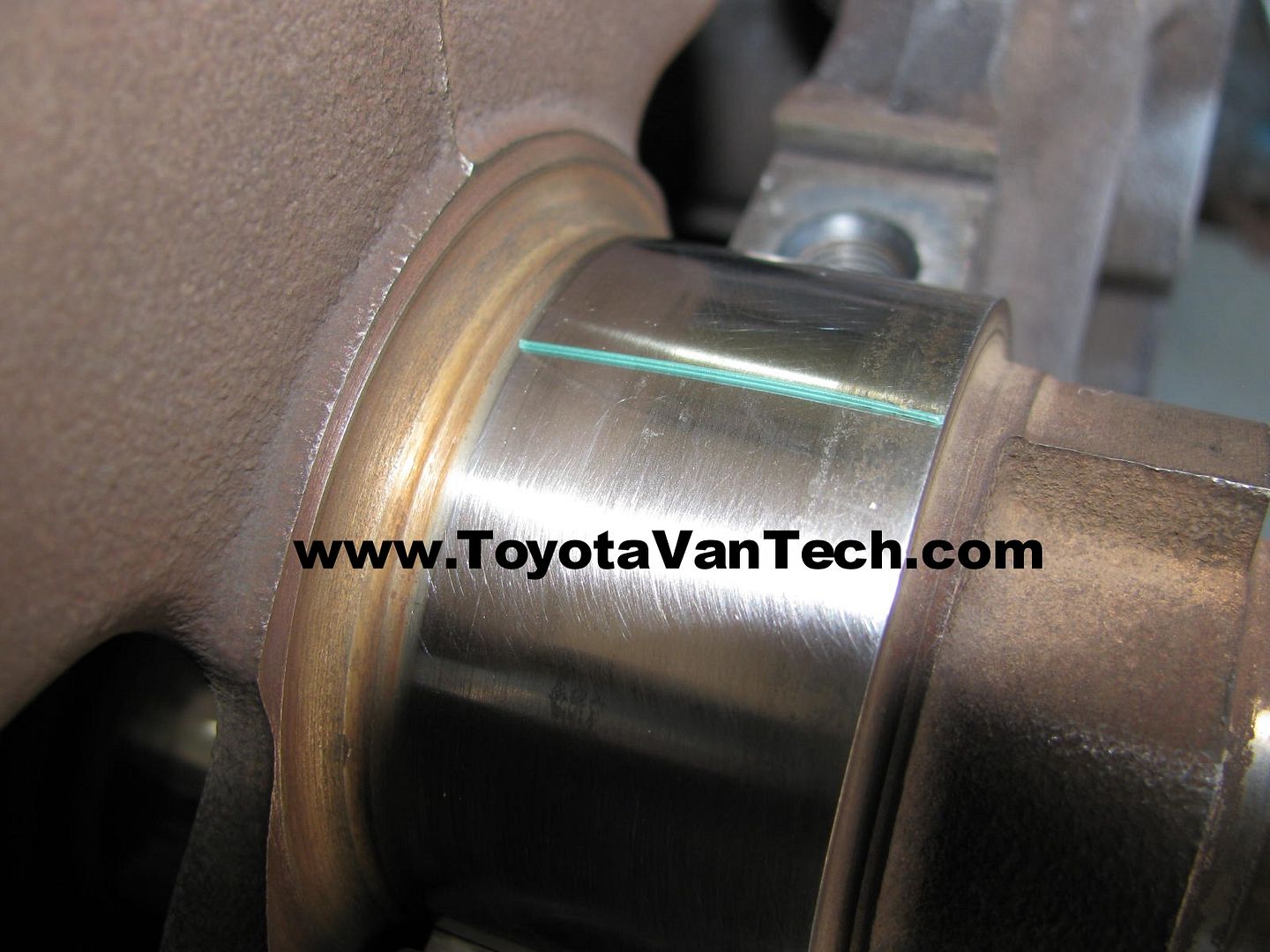
Being careful not to rotate the crank, bearing cap is removed and I use the paper sleeve of the Plastigauge to confirm correct clearance.  If this one's good, I'm going to assume they're all good
If this one's good, I'm going to assume they're all good  .
.
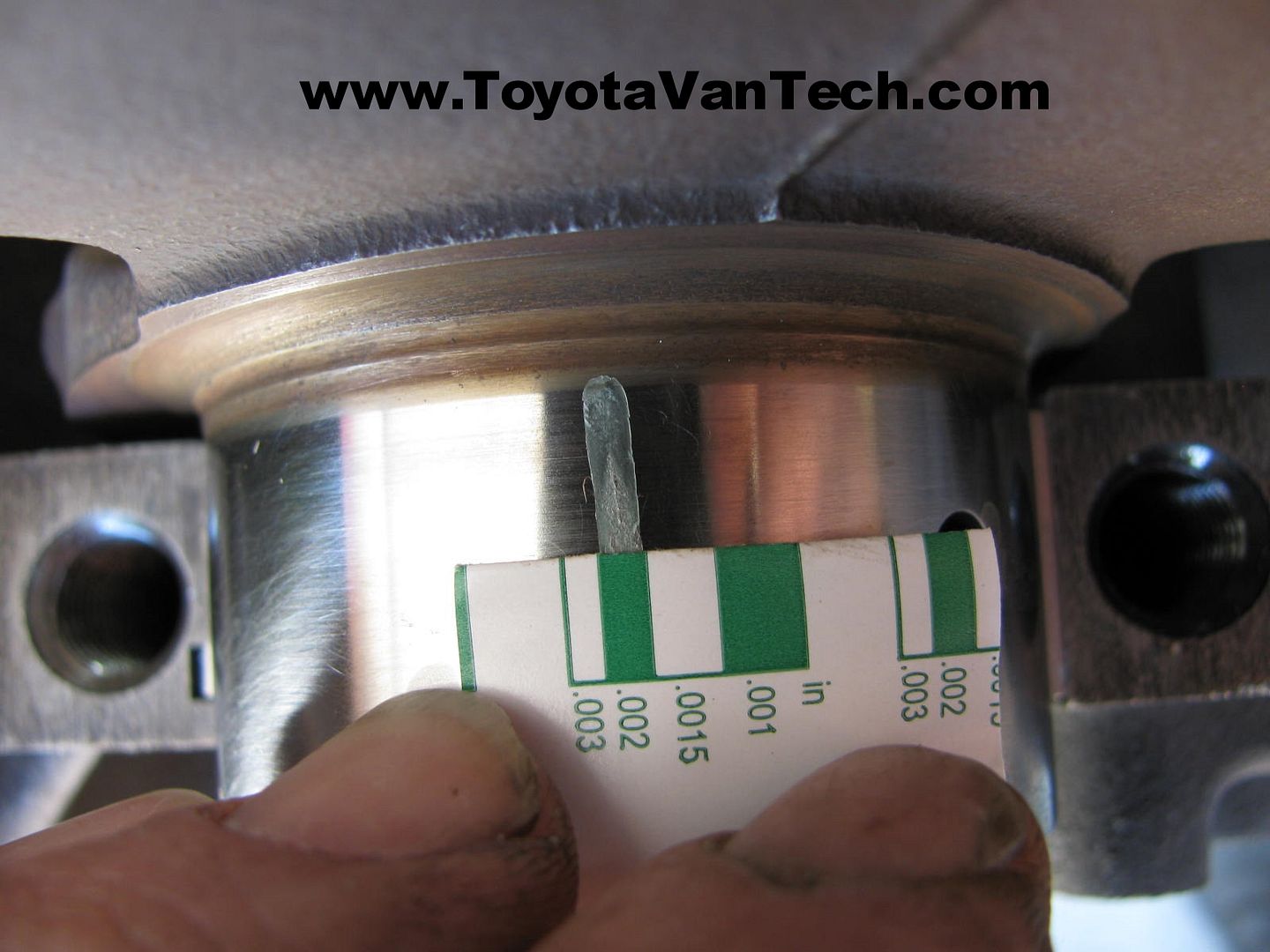
Next I clean the Plastigauge off the journal/bearing & remove the crank. I put a few drops of assembly lube on each main bearing surface.
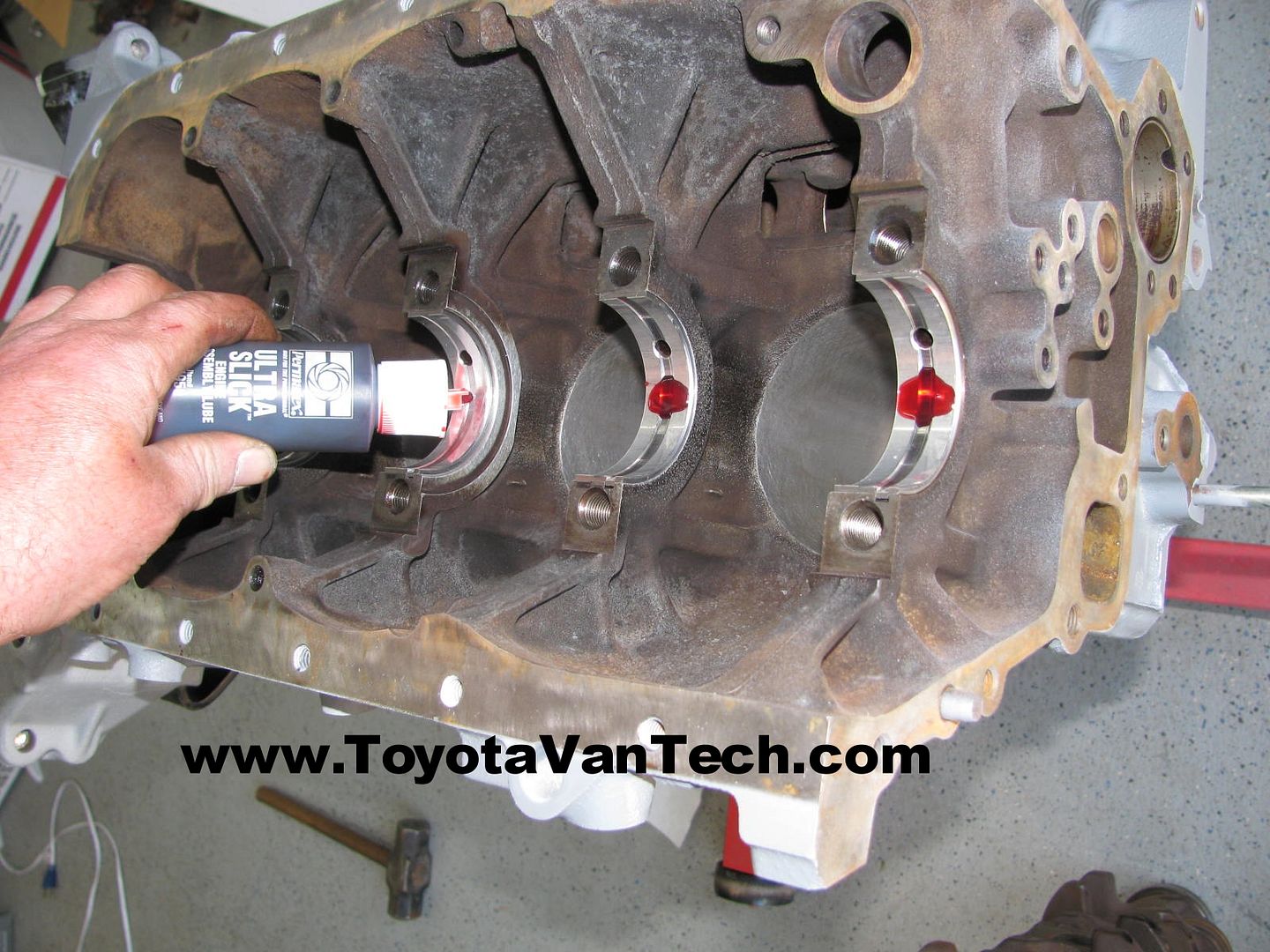
Crank is set on the bearings and more lube is applied. All main bearings are installed with main bearings & thrust bearings. All bearing bolts are lubed (threads & underside of heads) & torqued to 58 ft lbs. After torquing, I give the crank a spin to verify there is no binding. Cranks spins freely. For more detailed information on crank installation CLICK HERE.
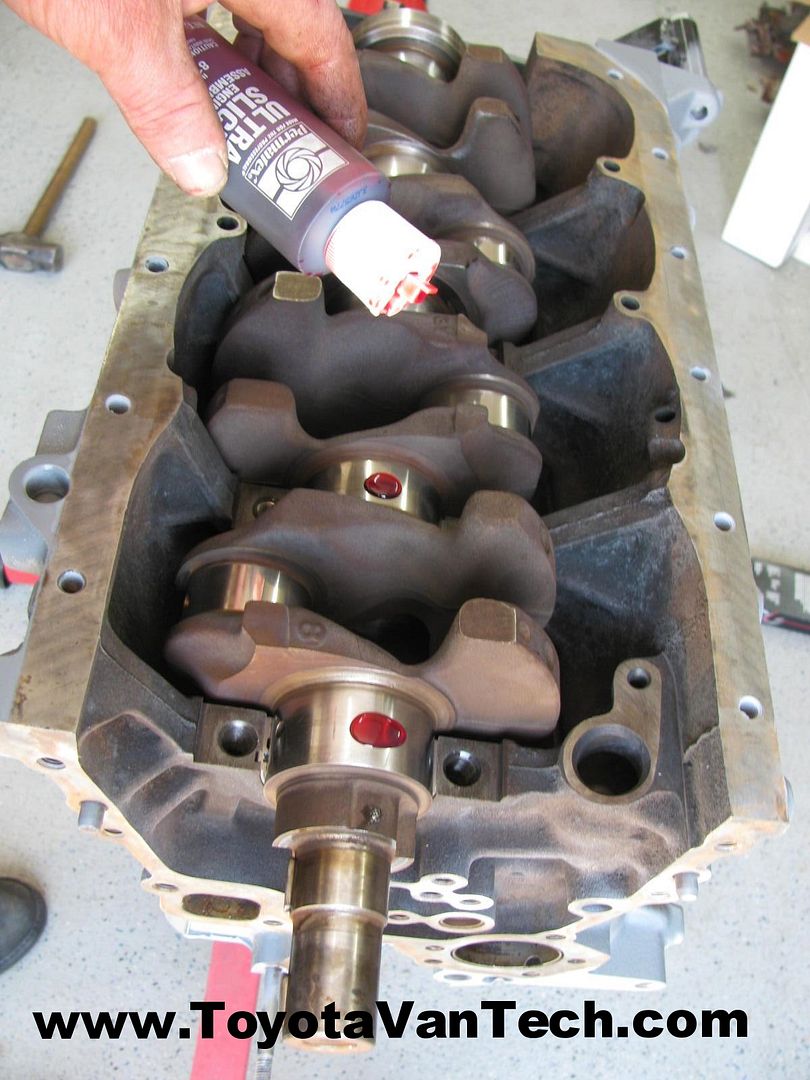
Next I drop a piston into it's hole and repeat the Plastigauge test on a rod bearing.
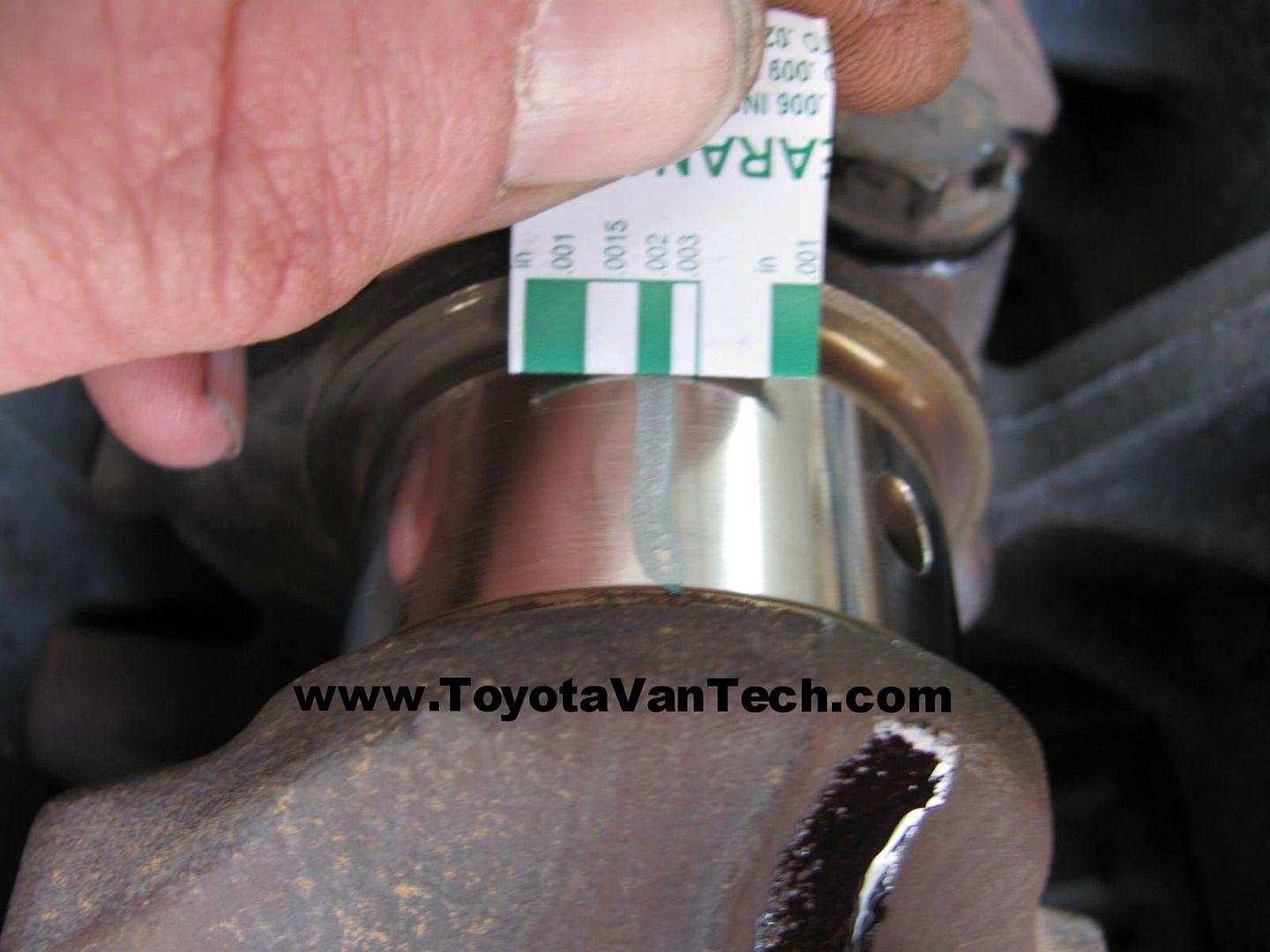
I remove piston & clean Plastigauge residue from the crank & bearing. I install piston rings on all the pistons and put some assembly lube in the bore & on the rod journal.
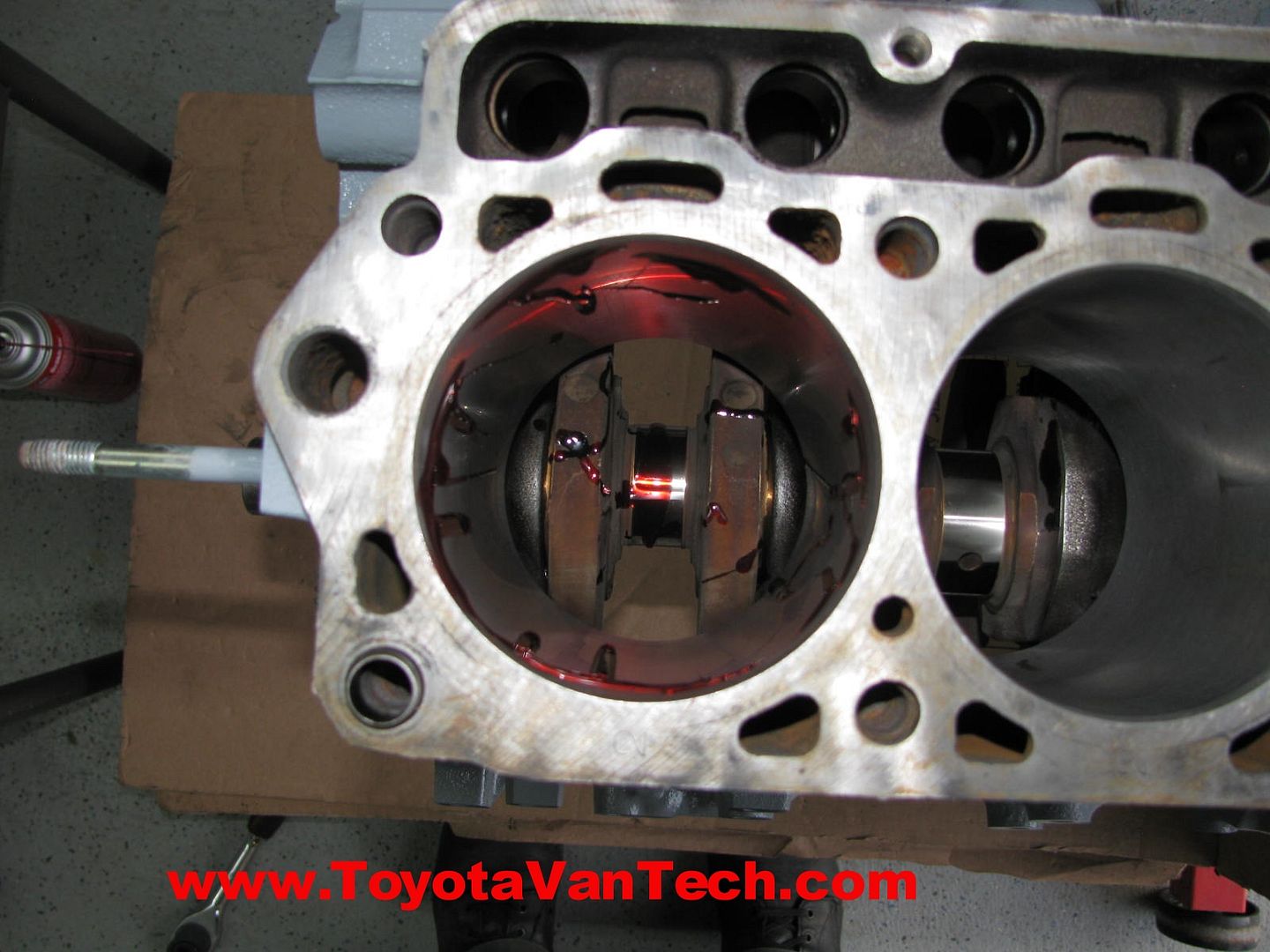
Piston is dipped into engine oil (weight & type doesn't really matter, but I'm using Mobile 1 synthetic 10w30). While dipped I work rod back & forth to lube wrist pin.
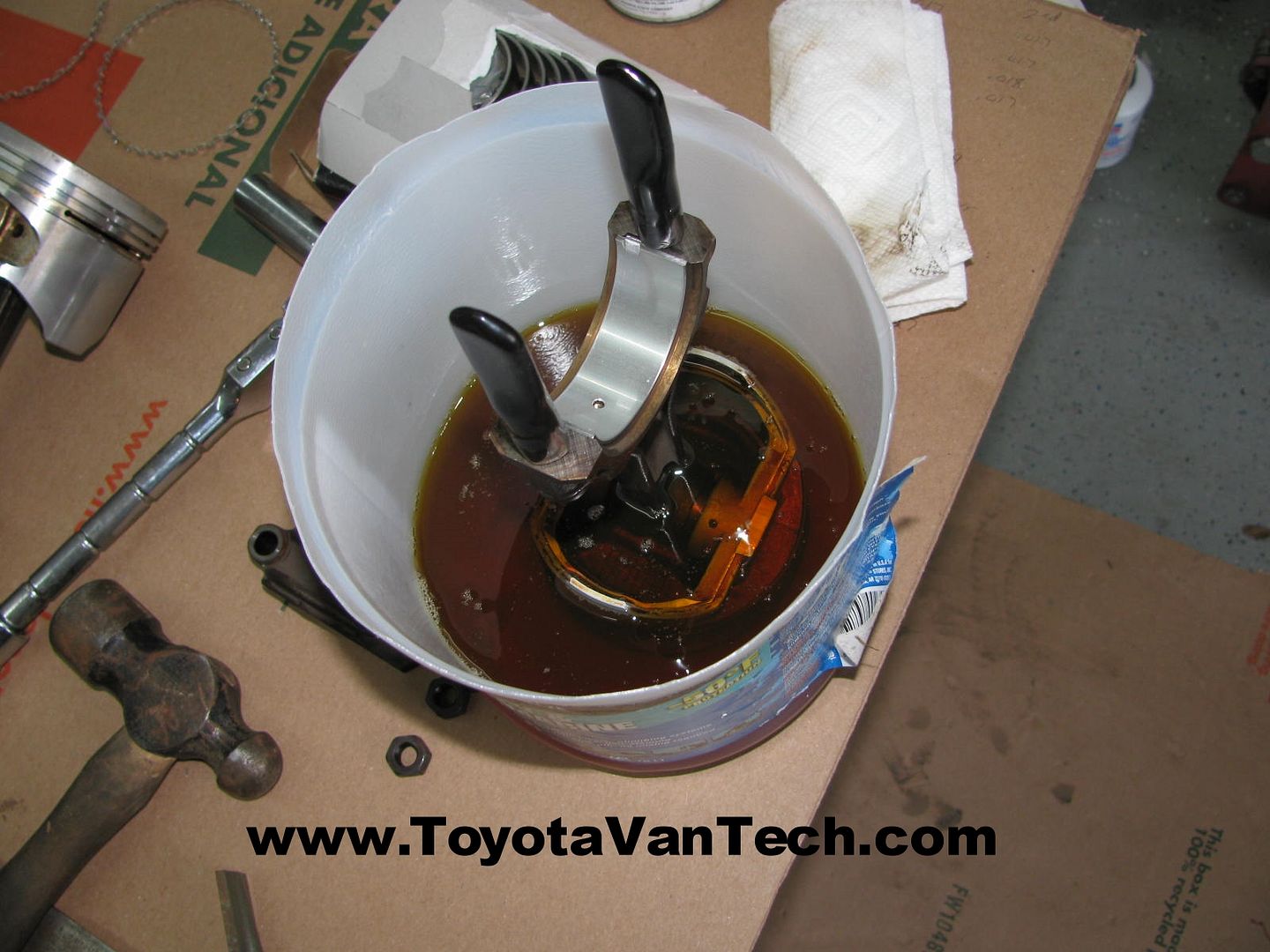
Using piston ring compression pliers, piston is lowered into cylinder (note the protective rubber on the rod studs). I use the handle end of a hammer to tap the piston down into the cylinder. Care is taken to keep the piston ring compressor sleeve flat on the deck. If a ring slips between the sleeve & the deck, piston will stop moving & you'll need to start over. After piston is in place, rod caps/bearings are installed and torqued to 36 ft lbs. More detailed information on this process can be found HERE.
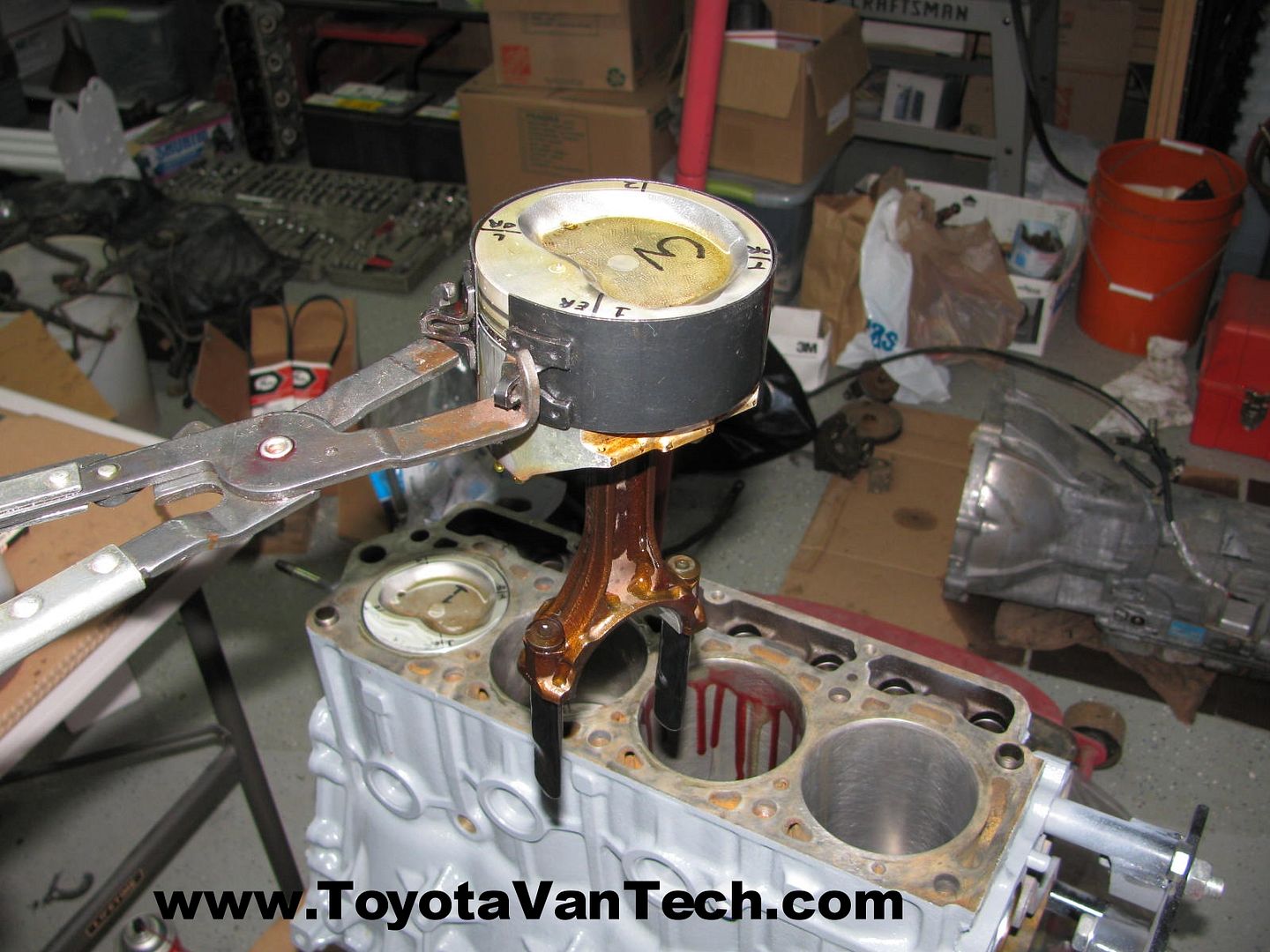
-
Re: Blew the rear main oil seal!
So, the purpose of this thread was to show an alternative to complete rebuild. Since we're to the assembly stage that part is finished. I had planned to end the thread here & refer you to my blog for the rest of the assembly process, but of course there were problems, so I thought I'd share them with you.
ANYONE PLANNING TO REPLACE YOUR TIMING SET TAKE NOTE:
This is the 2nd time I've used an aftermarket timing set on a 4y engine and the 2nd time I've had interference problems. As a result I have to assume this is a common issue with aftermarket timing sets. The 1st time I used the brand name "Engine Pro" part #C4057S & documented these problems HERE (in my blog). The Engine Pro timing set interfered with the washers on the camshaft thrust plate bolts so I made it a point to never use that brand again. This time I used Beck Arnley #029-0119 (I had previously purchased 3 of these sets for $29 each on a www.rockauto.com closeout sale).
Before installing I checked the area that had been a problem on the Engine Pro gear & found it to also be a problem on 2 of the 3 Beck Arnley sets. That area was good though on the 3rd set so I went ahead & assembled it. Once assembled I checked for end play and just like before there was none. So I took it back apart to investigate & here is what I found:
Damage on the edges of these 2 bolts.
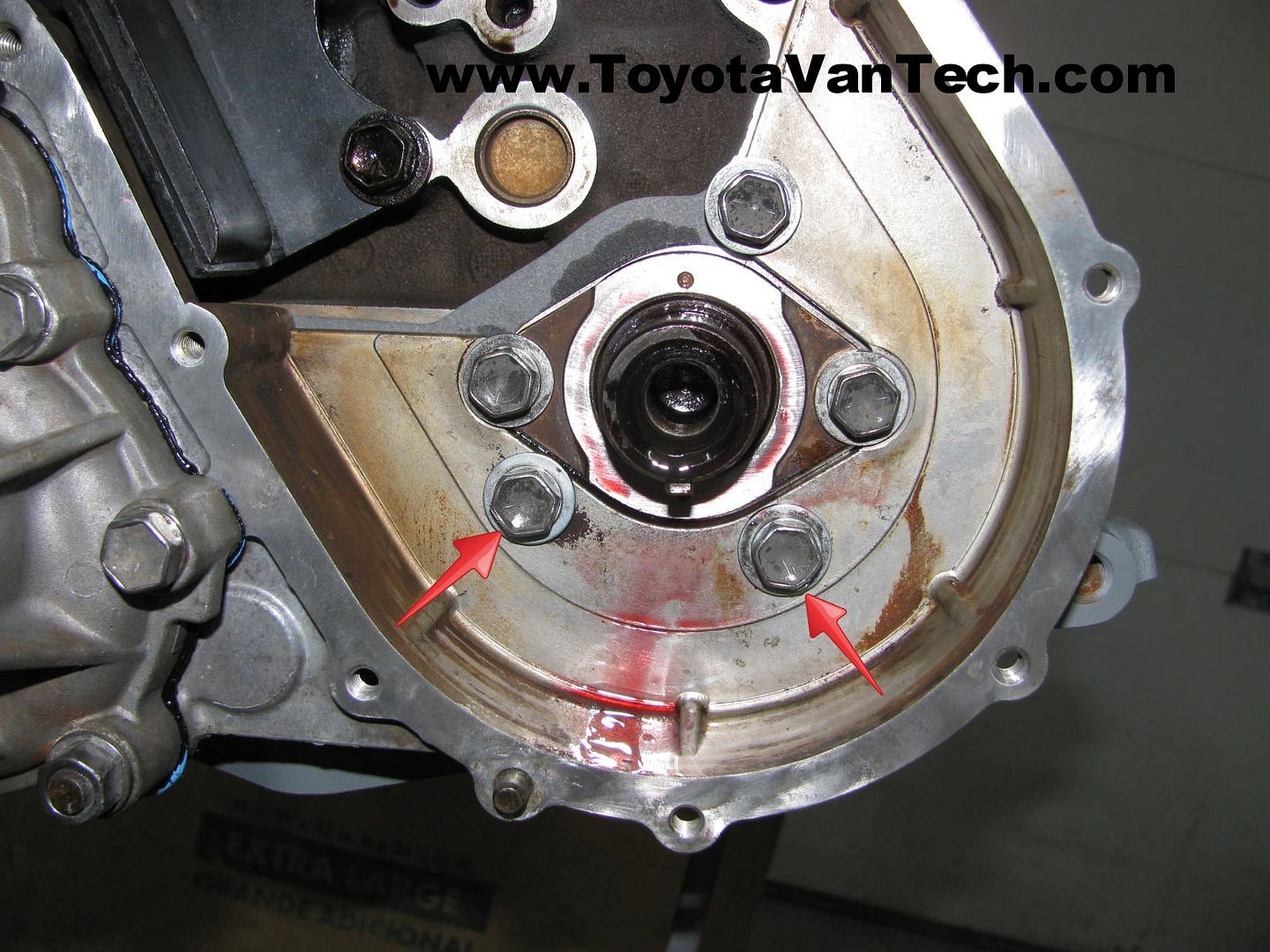
This one was the worst.
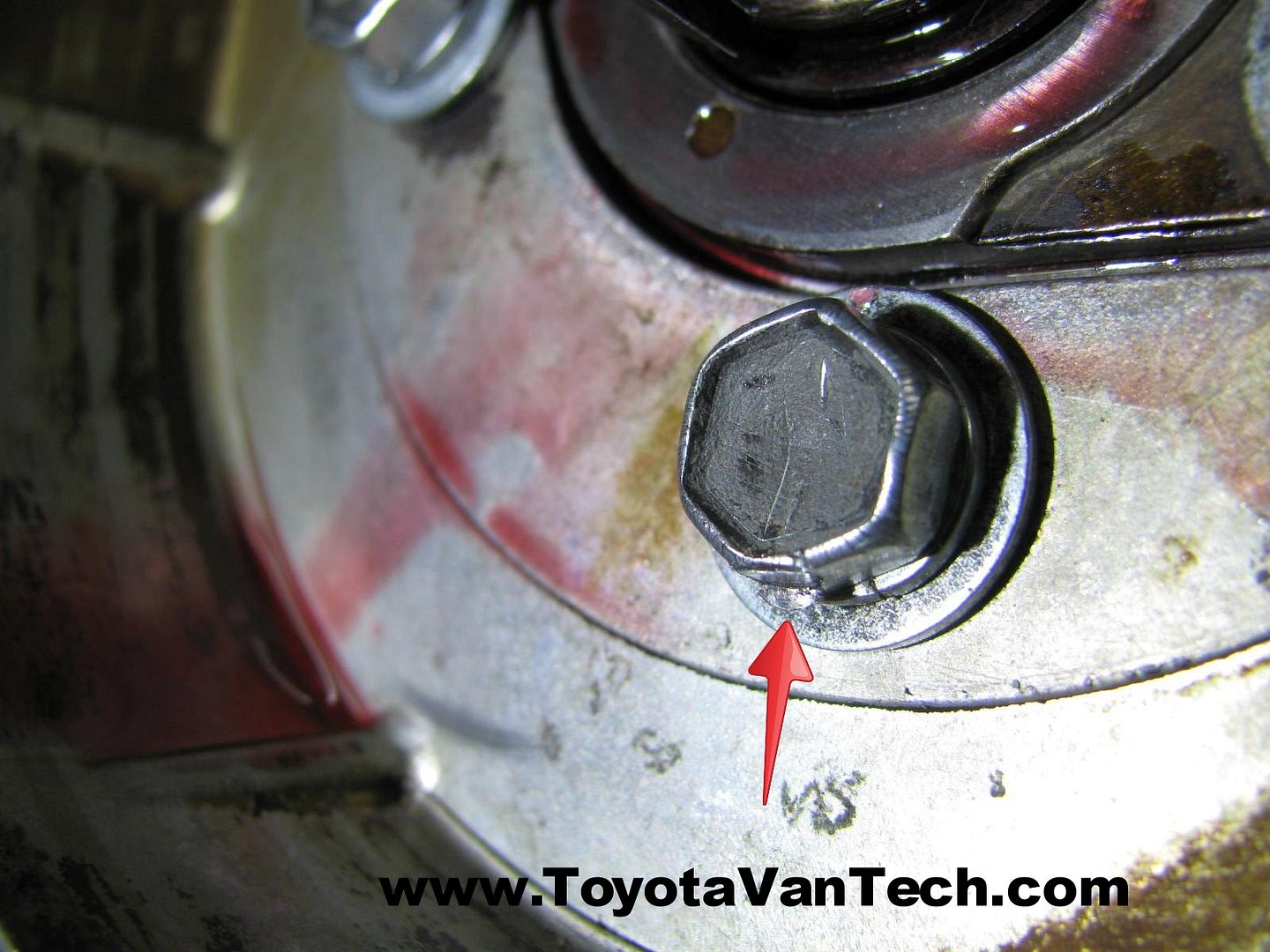
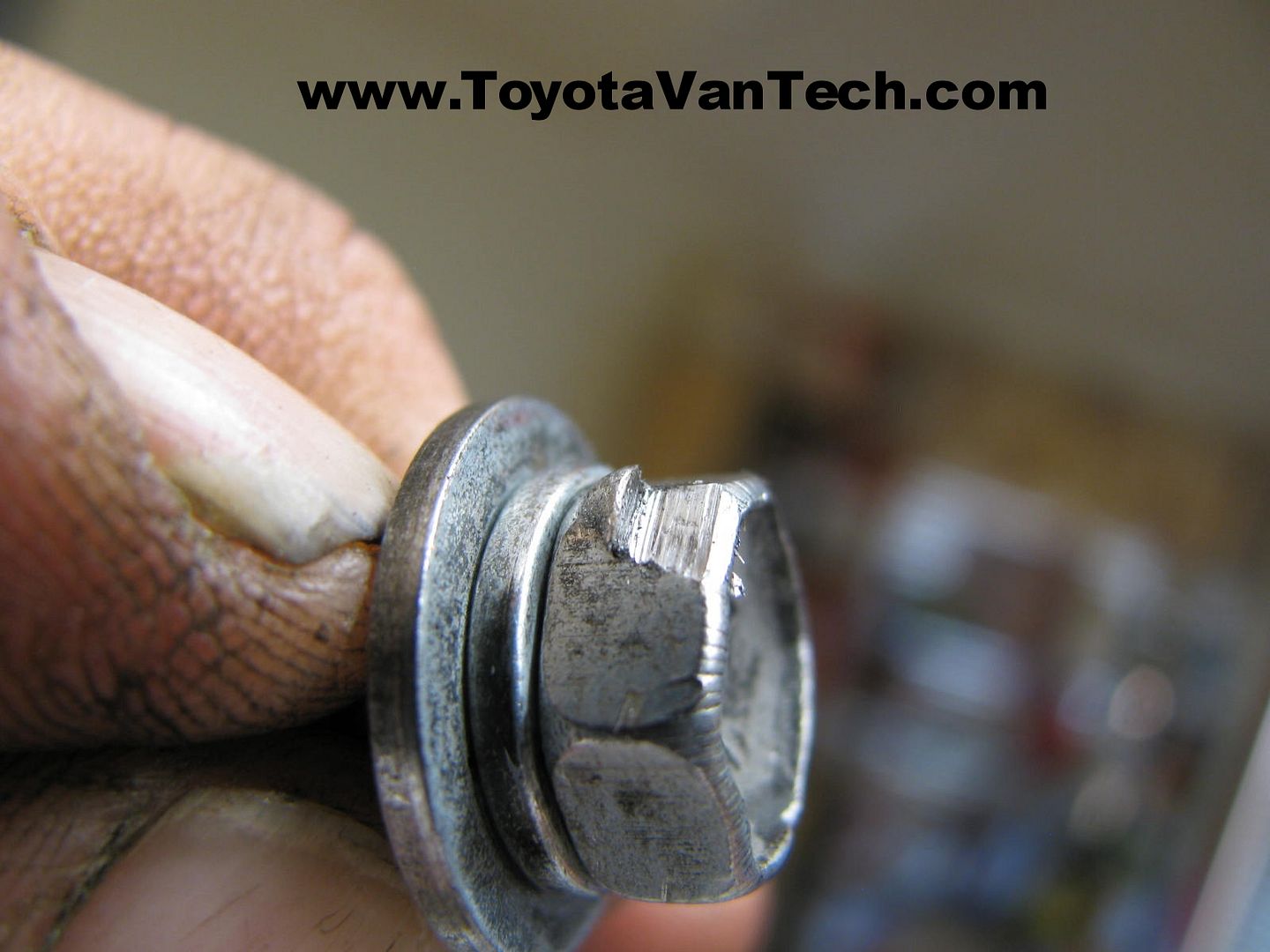
Here's the other one

On inspection of the cam gear, I found scuffing to the inner edge here:
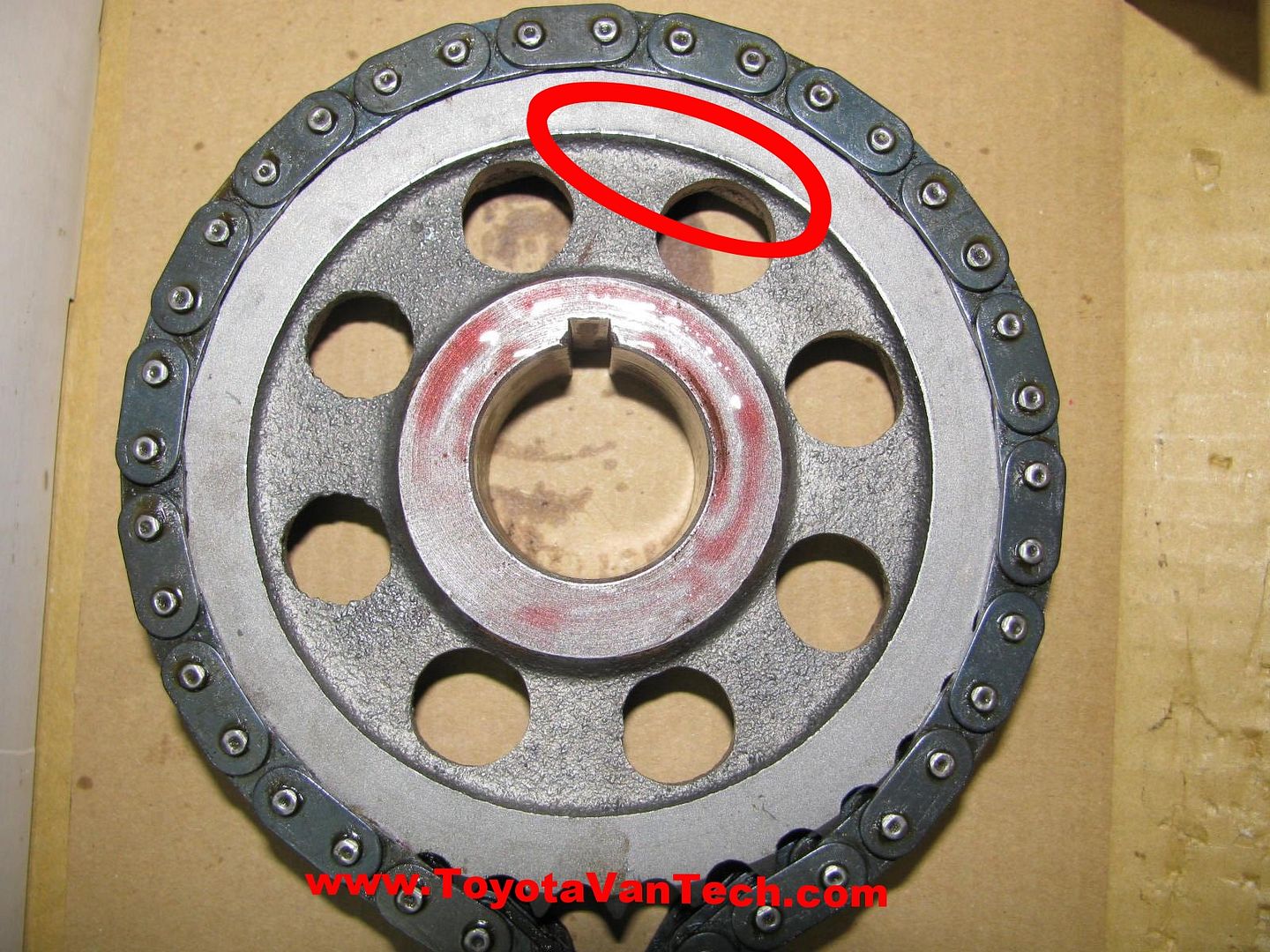
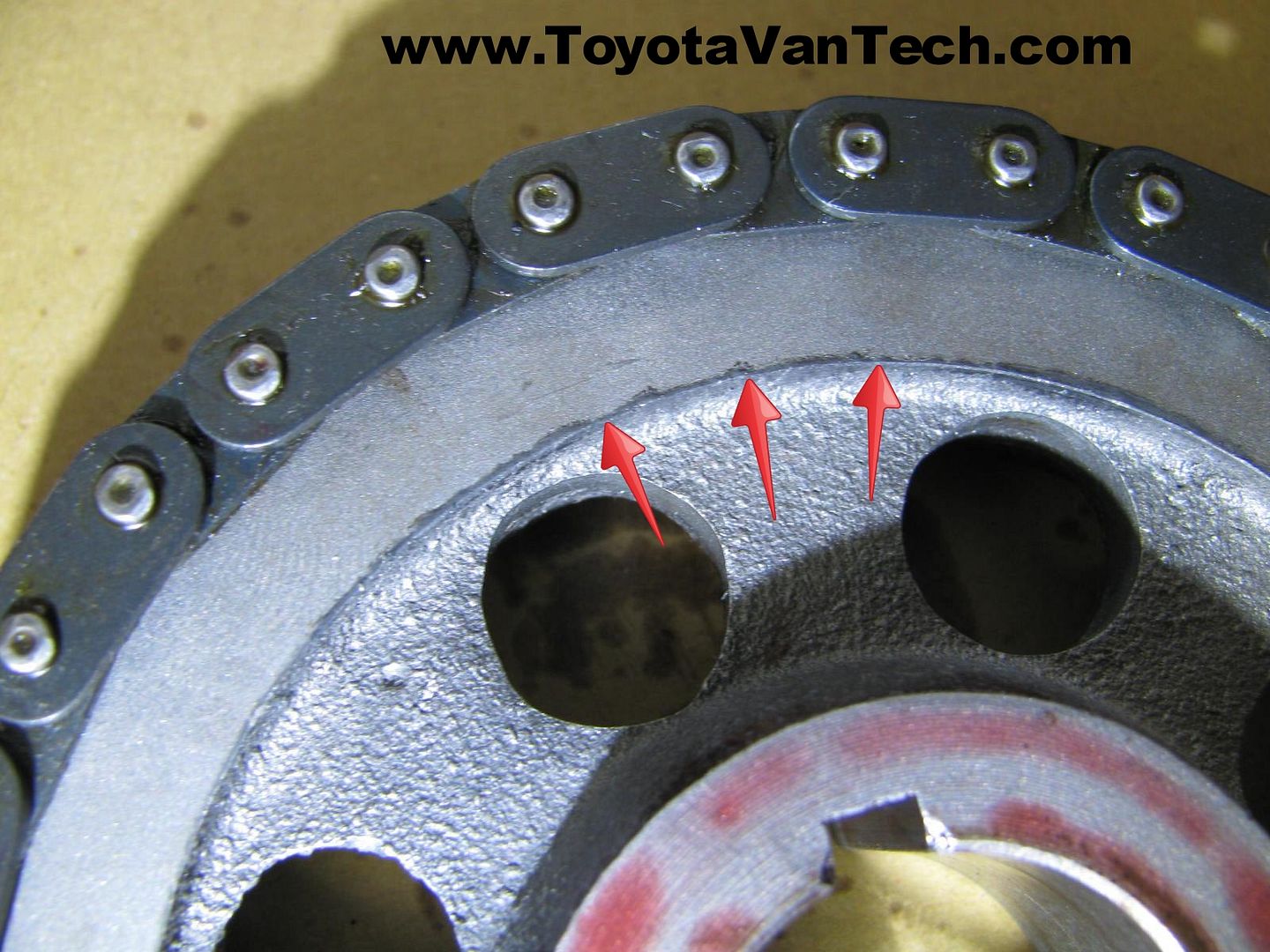
Here's the new & old gears sitting side by side (new on left, old on right)
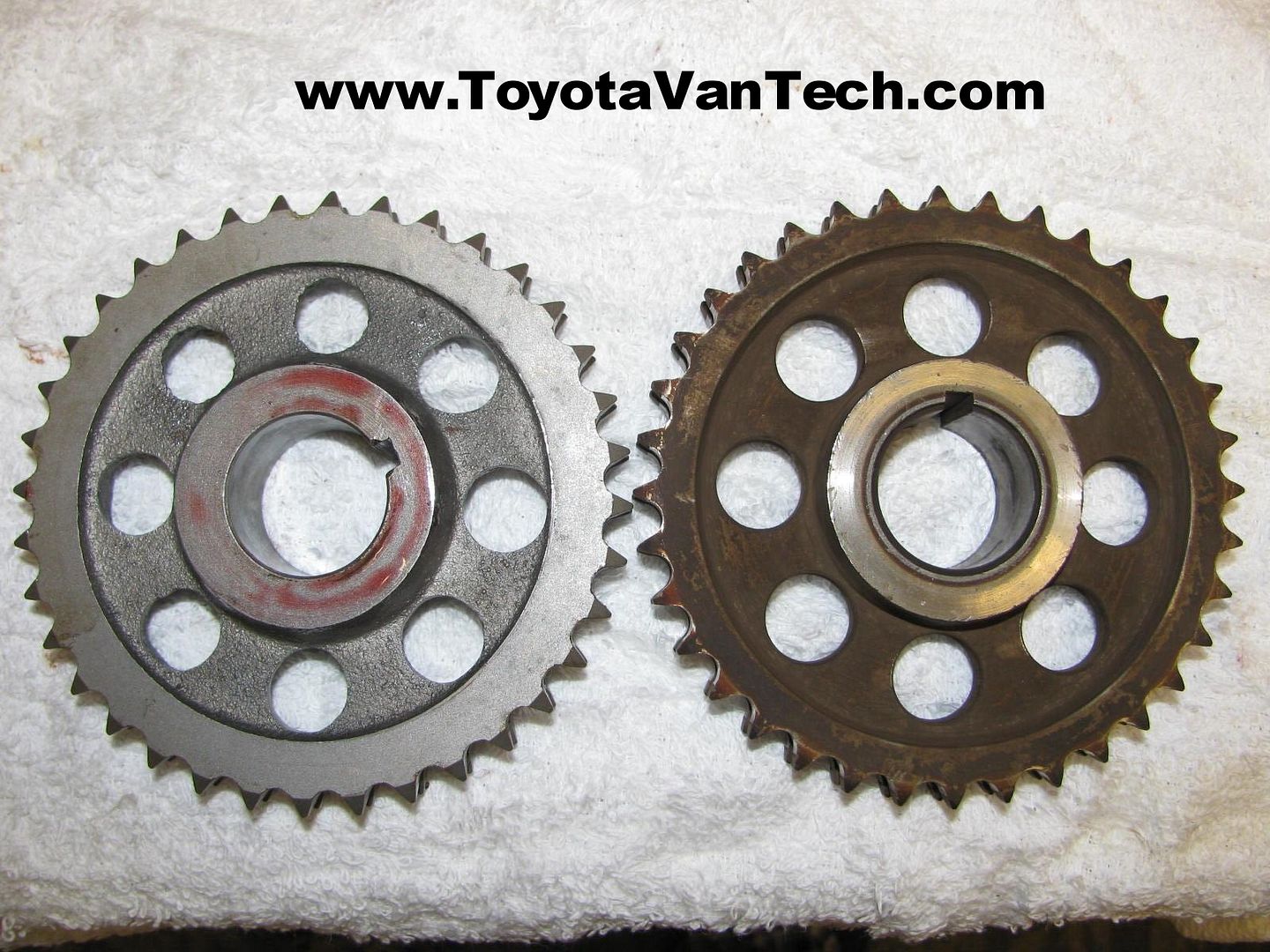
Old gear measures .273" from minor diameter to recessed area.
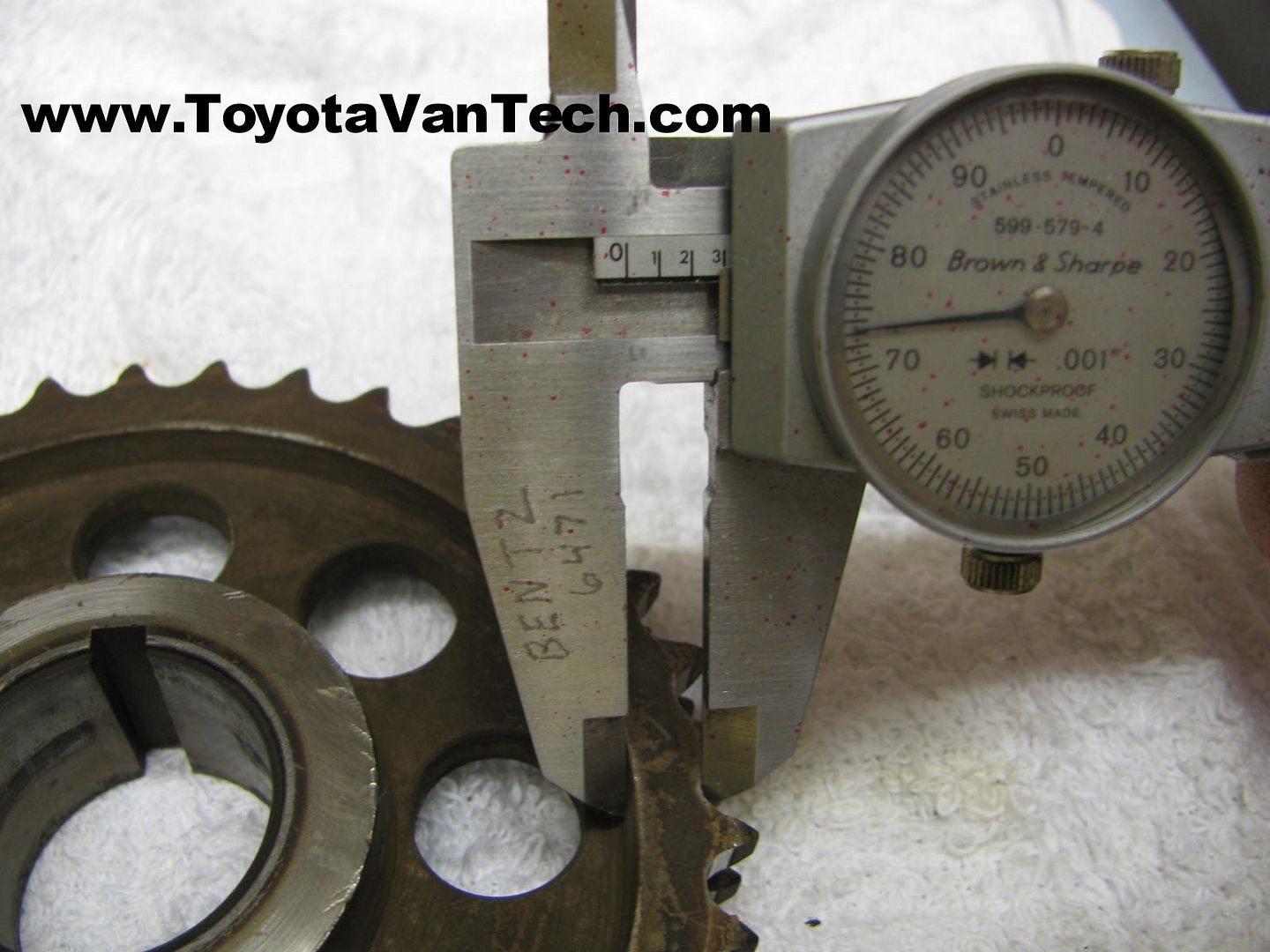
New gear measures .386" in the same spot........this explains my current problem.
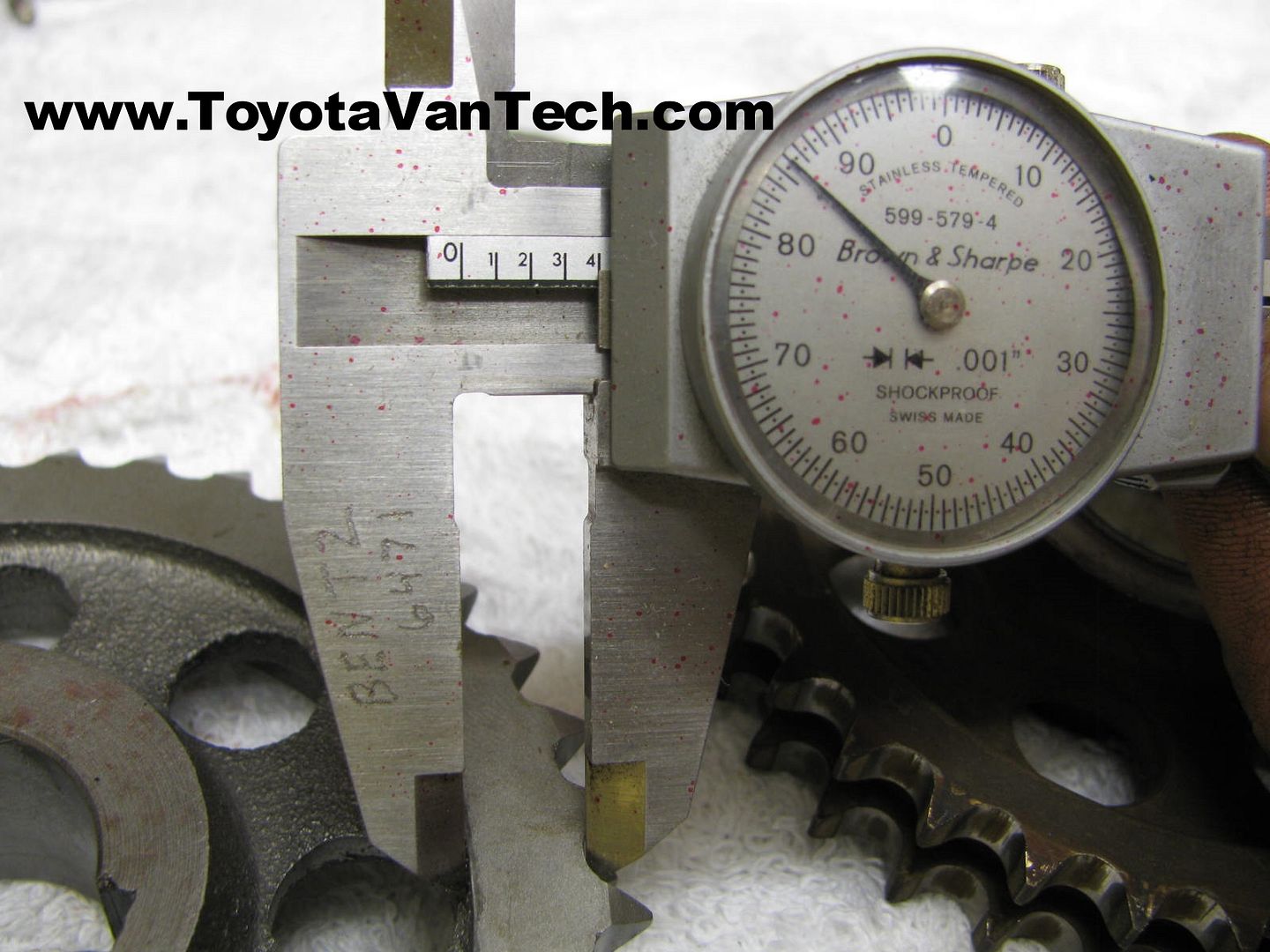
I measure the other 2 new gears I have & find they both have the same issue. This annoys me immensely & I decide to find another timing set. I call around & surprisingly found one in stock at Discount Auto Parts in Vancouver, WA. I ask the brand & part number........guess what? You guessed it, Engine Pro #C4057S  . So here's the thing, I really don't want to spend a lot of money on this (futile, I know) and I don't want to delay this project, so I grind down the high spots on both bolts & install them back in the same spots as before
. So here's the thing, I really don't want to spend a lot of money on this (futile, I know) and I don't want to delay this project, so I grind down the high spots on both bolts & install them back in the same spots as before  . It's not the high road, but it does the job. Once back together I check for end play and it falls into an acceptable range. I rotate a full revolution and verify there is no more rubbing/grinding on the bolts. When I have time I'm taking the other 2 gears to my local machinist and having this material removed. Next engine I do WILL NOT have this issue!
. It's not the high road, but it does the job. Once back together I check for end play and it falls into an acceptable range. I rotate a full revolution and verify there is no more rubbing/grinding on the bolts. When I have time I'm taking the other 2 gears to my local machinist and having this material removed. Next engine I do WILL NOT have this issue!
Here's my engine with the camshaft, timing set, timing cover, crankshaft pulley, & water pump installed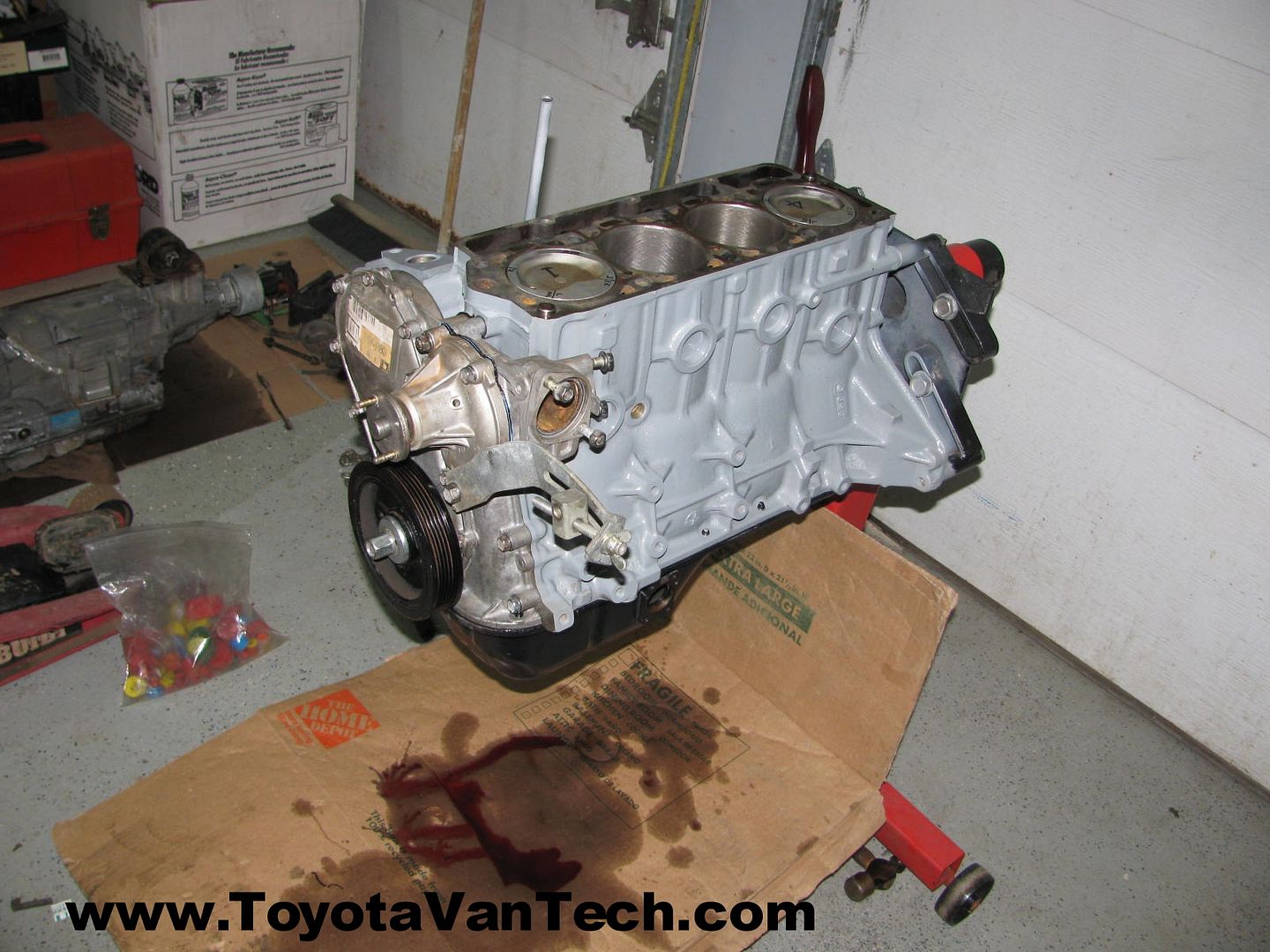
For more detailed information on camshaft & timing set installation CLICK HERE and HERE.
Update: I took my other 2 camshaft timing gears to my machinist and had some material removed. Here's a picture of one of the gears after modification:
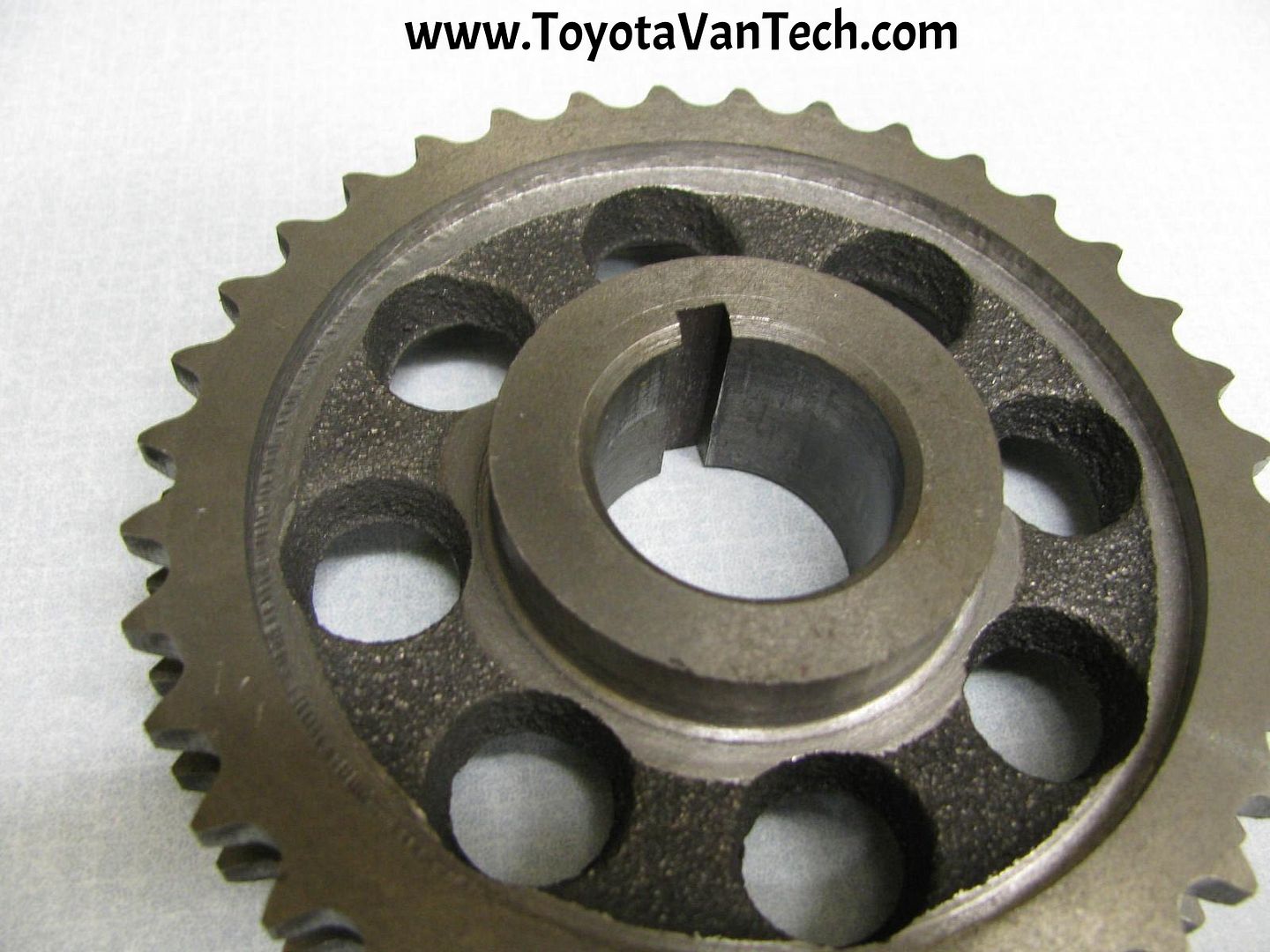
Note: Machinist charged me $40 per gear, so that means my $30 timing sets actually cost me $70 + a lot of wasted time. Hopefully this post will help save the next guy some time/money. Tim
-
Van Enthusiast


- Rep Power
- 1
Re: Blew the rear main oil seal!
I'm guessing these timing sets aren't available from
toyota anymore?
-
Re: Blew the rear main oil seal!
I'm guessing they are actually (although Toyota doesn't sell in kit form.......all parts sold separately). On my other engine the rebuild kit came with the timing set. It looked like good quality (and other than this flaw I believe it is). The problem was I didn't figure out the flaw until I needed it and since I was able to fix, and wasn't willing to wait, I went with it. With the Beck Arnley timing sets it was something I had on hand & I didn't want to spend any more money unless absolutely necessary. Of course when it came down to the wire I would have, but Toyota never has anything locally & I didn't want to wait for it.
Other than this flaw, I believe all of these timing sets to be of good quality. It's just a shame that final fit was never checked and verified by manufacturer. In the manufacturing world it's very important to check these things on the 1st set (before making 10,000 of them). Only after you have a verified fit & function do you go into mass production (I guess they forgot that). Just one more simple machine process would have eliminated this problem. I'm guessing hundreds of these things have been installed like this without the installer having a clue. Just running the engine for a few minutes would have cured this, but metal shavings may have been produced and maybe ended up in the wrong place. One more reason to check clearances when assembling an engine. I wouldn't have known if not for checking camshaft end play. Tim
-
Re: Blew the rear main oil seal!
I'm going to skip past most of the assembling here as most of this is covered in my blog entries. I'll just brush on a few things, list some parts I recommend to replace, and elaborate a bit on problems encountered. For the bottom end gaskets & seals I used Enginetech #T02.2CS. For the top end I used a genuine Toyota Valve Grind Gasket kit part #04112-73035. One thing worth noting, although the van has an electric fuel pump (in the tank), the 4y has provisions for a mechanical fuel pump. The port (on the right side of the block) is simply blocked off & serves as a mount for the fuel filter. Since the port is still there, you still need the fuel pump gasket (2 of them.......one for each side of the spacer). For reasons unknown, most 4y gasket kits don't include this gasket. I got my 2 fuel pump gaskets (Fel-Pro 70627) off of Amazon.
Next thing I did was installed a new Aisin oil pump, installed the rear main seal housing, and the oil pan. I found the good Toyota FIPG on Amazon, so I used that to seal the pan. For more information on these steps, CLICK HERE. Note: due to the way my old engine blew the oil seal, I put FIPG around the periphery of this one (no taking chances).
Okay, so one thing I always do when I have a head off is use a dial indicator on the #1 piston to find true TDC (Top Dead Center). Once I'm satisfied #1 is at TDC I check the timing mark on the front pulley to verify it's in the right place. This procedure is outlined in detail at the bottom of the page HERE in my blogs. Usually these come out pretty close, but I was in for a bit of a surprise on this one. After finding TDC I checked the pulley and found it to be almost 8 deg off! I made a new notch in the pulley and filled it with yellow paint.
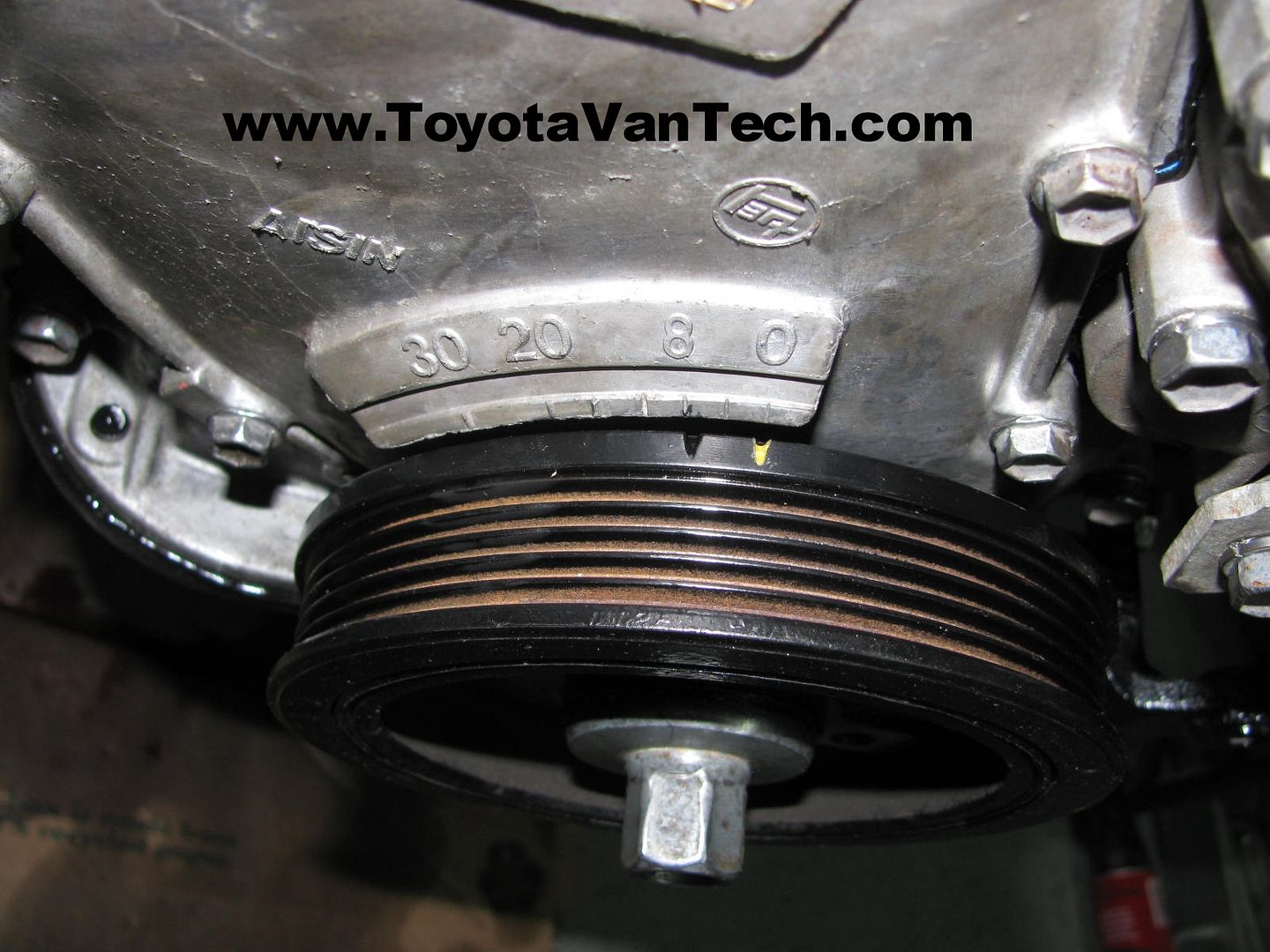
Now is a good time to mark 12 deg BTDC spot on my timing cover. This will make timing the ignition easy when I start it up.
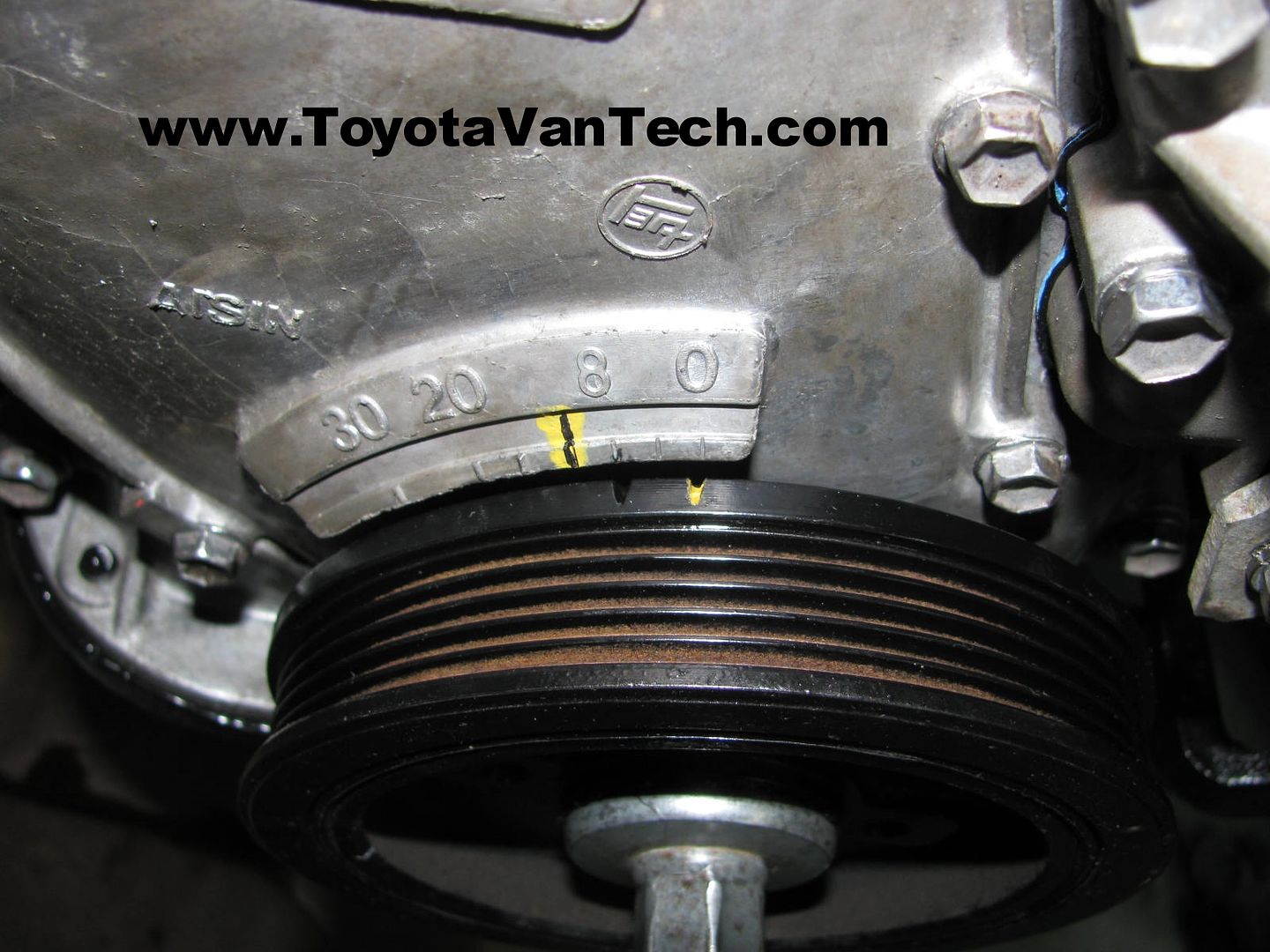
Next I proceed with installing the head & general engine assembly. Nothing special or unique here so I'll simply refer you to Part 13 of my blog for detailed information. The only thing different with this project is I'm using my old push rods & head bolts (and yes, old push rods are put back in exact position as before). Due to age and condition, I opt to replace some parts with new during assembly. One such part is the exhaust manifold Toyota part #17141-72010. I was lucky enough to buy this off the site classified section a couple years ago. The poster had sold his van before doing this job & I got a great price on this. It had sat in a humid environment and had some surface rust, but not bad (had no effect on anything other than cosmetics). One thing that happens with any high mileage engine is the degradation of fasteners attached to the exhaust manifold. When replacing the van manifold, you can count on replacing all these studs. Here's a list of them along with their part numbers:
Studs 90116-10058 (qty:3)
Studs 92122-40610 (qty:6)
Studs 90116-08128 (qty:2)
Nuts 90179-06194 (qty:6)
Nuts 90179-08059 (qty:2)
Nuts 90179-10070 (qty:3)
Any time an engine is out and getting this type of service, I consider it a must to replace certain parts. The fuel pulsation damper & fuel regulator are 2 such parts. I use Standard/Intermotor part #FPD4 for the damper and Toyota #23280-73040 Fuel Pressure Regulator. Note: I have tried aftermarket pressure regulators on 2 previous occasions and the results were less than satisfactory, so as much as it pains me to pay Toyota's prices, I consider this one important enough to only use OEM. I've been generally happy with the Standard #FPD4 dampers, but have noticed the threads to be a bit rough. As a result, I chase them with an M12 X 1.25 die & then they thread onto the fuel rail easily.
Injectors.............any time you have these out on a high mileage engine, it's just a good idea to have them cleaned & tested. I've done this with dozens of 20+ year old Toyota injectors and never had one that didn't come back after cleaning............until this project. I took these down to DR Injector in Gladstone Oregon to be cleaned & tested. All failed the initial test miserably. After cleaning they were tested again. One came back within specs, 2 performed marginally, and the 3rd failed miserably. I went ahead and tossed them all and replaced with rebuilt injectors from DR Injector. He charged me $45 each. For more information on testing & cleaning injectors CLICK HERE.
Engine mounts.........I've found the driver's side mount is usually broken on vans with over 150k miles. For this reason I replace the motor mounts with DEA #A7229 (note: 2 of these are required).
Power steering pump...........I disassemble this and replace seals & o-rings. I use Edelmann #8598 Power steering pump seal kit
Throttle body...............I clean & rework it using the techniques described HERE and install/calibrate a new Beck Arnly #158-0503 throttle position sensor. Note: ignore that picture in the Amazon listing, it's incorrect. I assure you the TPS you get will be the correct one.
Alternator...........I install a Denso part #210-0272. This is a remanufactured alternator, but it's remanufactured by Denso. Denso knows their products the best & these are quality units (much better than your average rebuild sold by most auto parts stores.
Rubber hoses.........CLICK HERE for a list of what to buy.
BVSV (Bi-metal Vacuum Switching Valve). Very rare you can remove this and put it back without breaking. It's Toyota part #90925-05017
One thing that always annoyed me with the van is the requirement to remove the top half of the intake manifold just to connect/disconnect the engine wire harness to the fuel injectors. The last time I did this I cut the injector part of the harness off & built a removable injector harness (it worked great). This makes it possible to completely assemble the engine before installation. I liked it so much I built a removable harness for this one too (old connectors were shot anyhow). I'm using Standard part #S697 Bosch style injector connectors w/wire and 4 PIN SQ 16-14 AWG Weatherpack connectors. I use 16 AWG automotive primary stranded wire to go from the injector connectors to the Weatherpack connectors. I solder & shrink tube the connections to each injector connector wire, then cover the assembled harness with more shrink tubing. Note: Special crimpers are required for the Weatherpack connectors. If you work with these type connectors (also used on GM) I highly recommend having a Delphi Packard Weatherpack Terminal Release Tool in case you need to pull pins back out. Here is the finished harness:
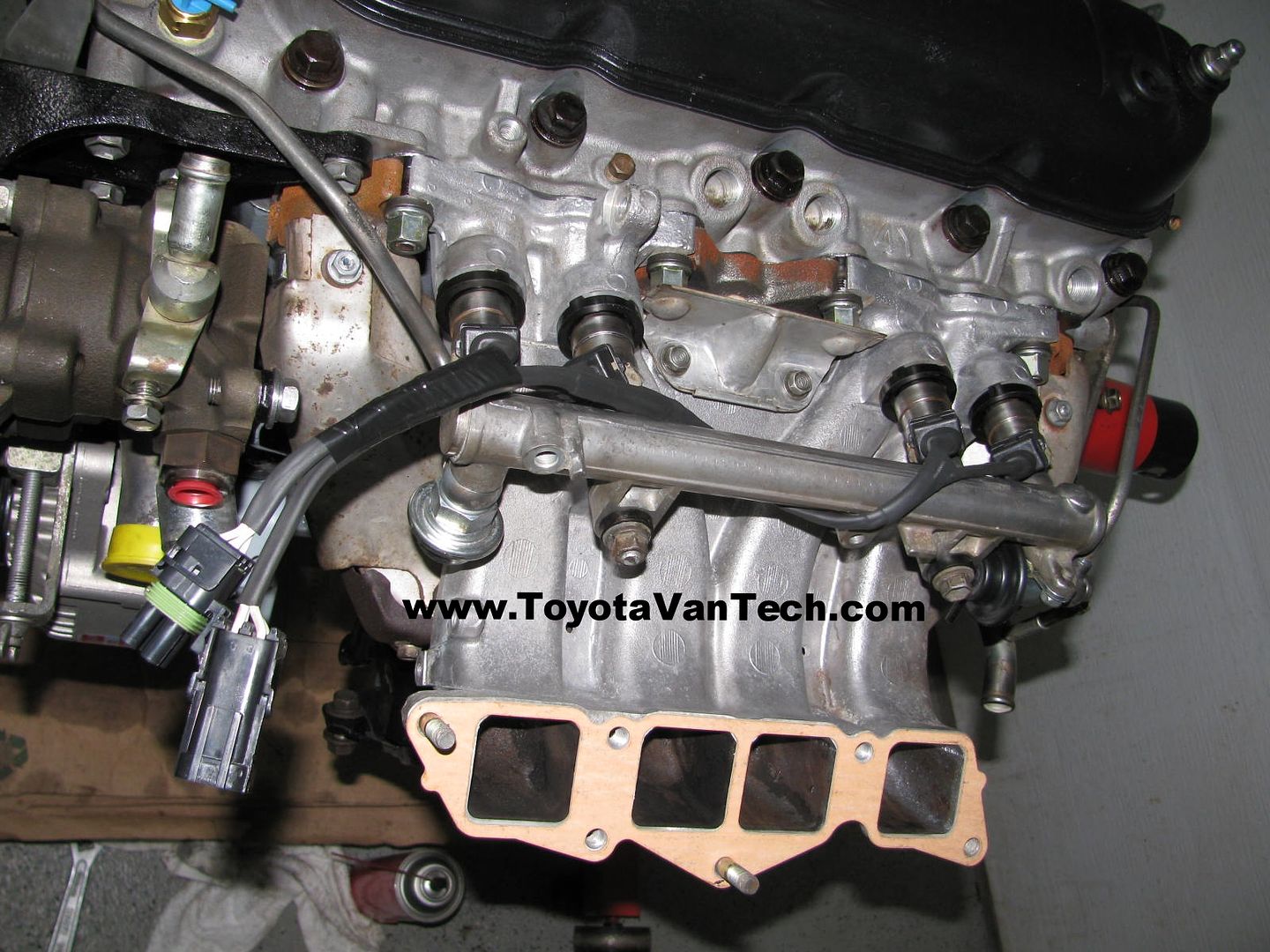
Male connector positions A&B power injector #1 & positions C&D power injector #2. Female connector positions D&C power injector #3 & positions B&A power injector #4.
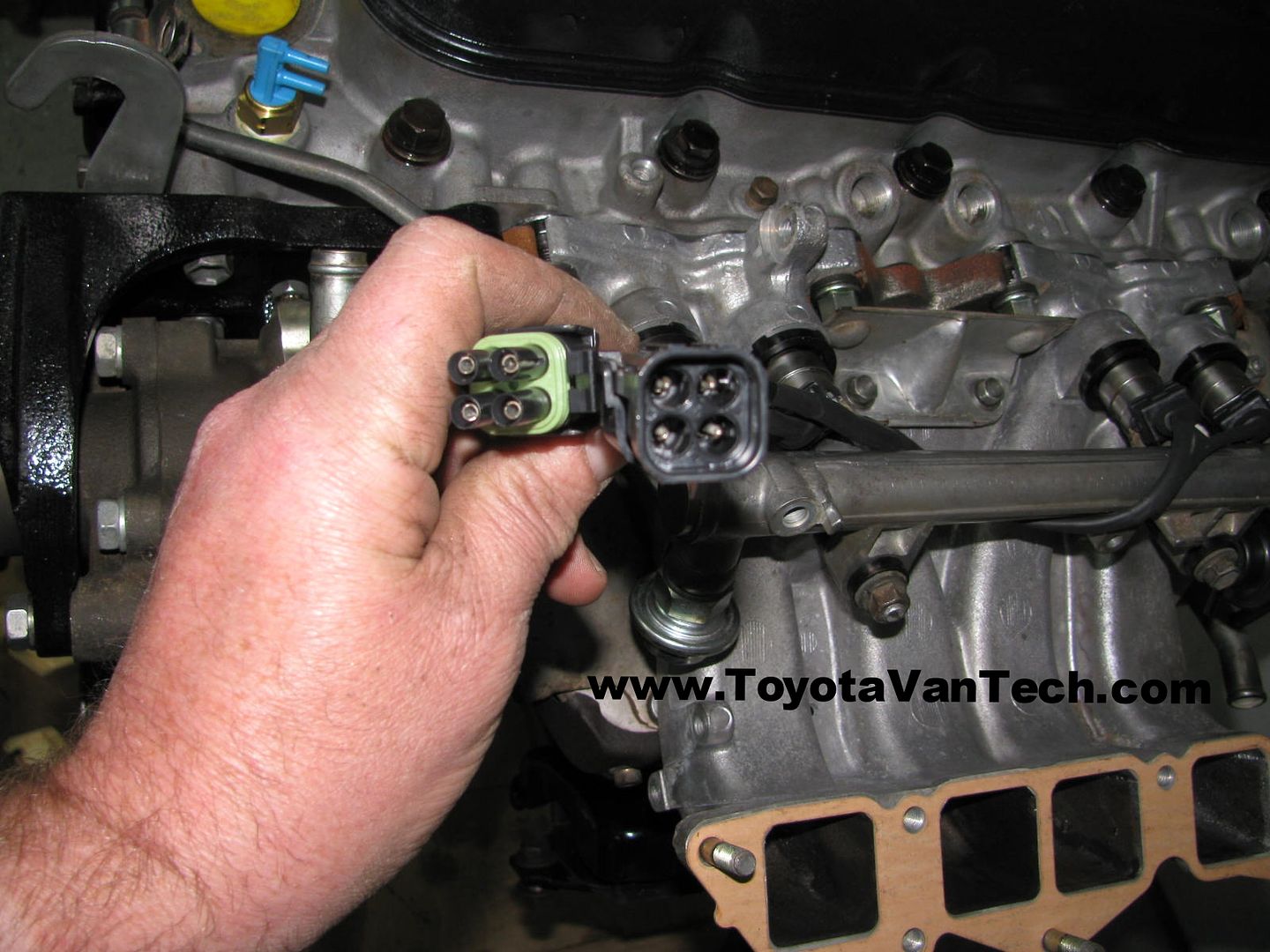
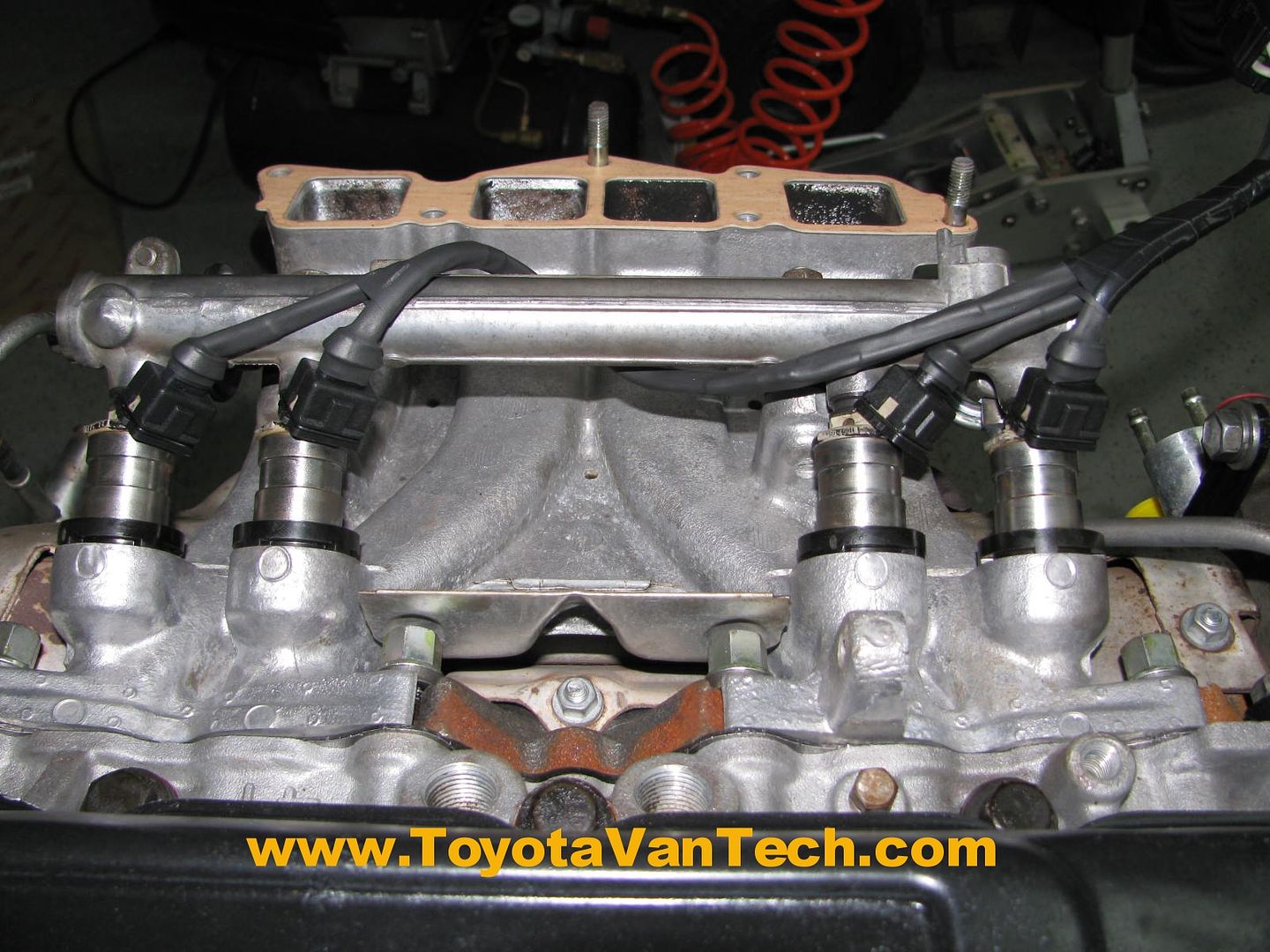
Upper intake...........This thing was filthy & stained. I decided to polish it. I didn't go hog wild, just a rough polish using my die grinder & some Scotch Brite surface conditioning pads. This took me about 2 hrs to do. By no means was this necessary, it just made me feel better  .
.
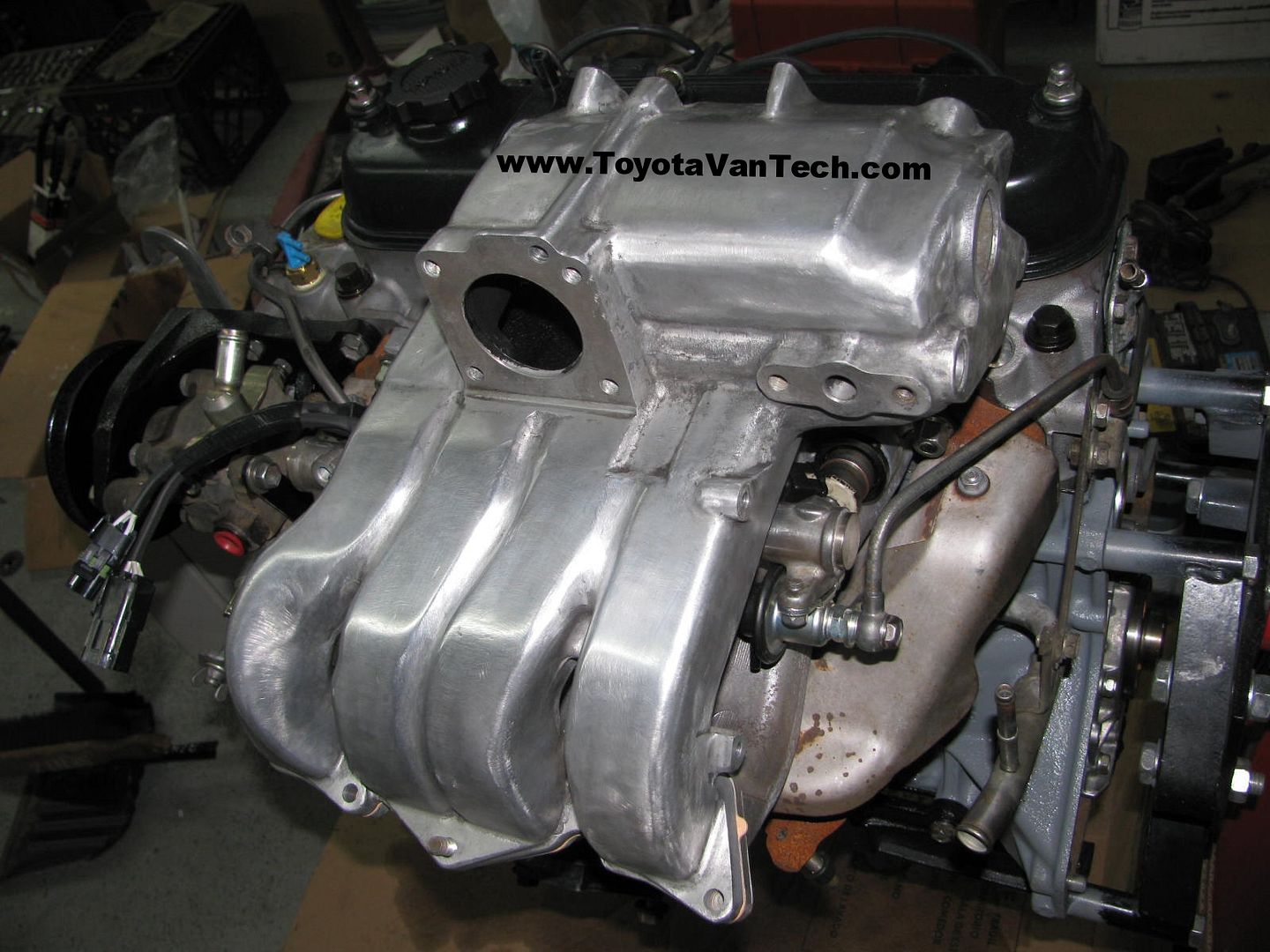
Here's a few pics of the engine after assembly. Next post will be installation 
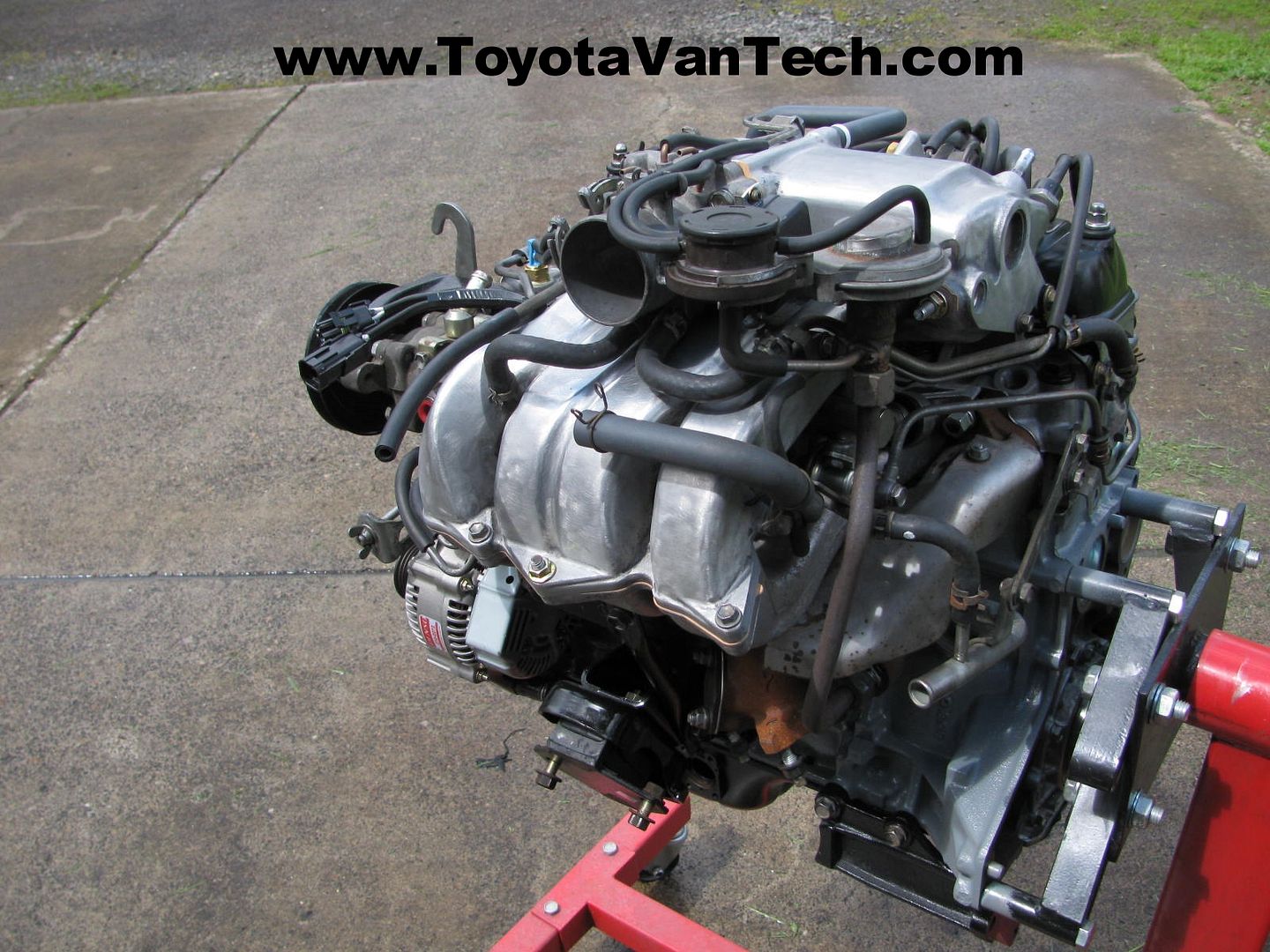
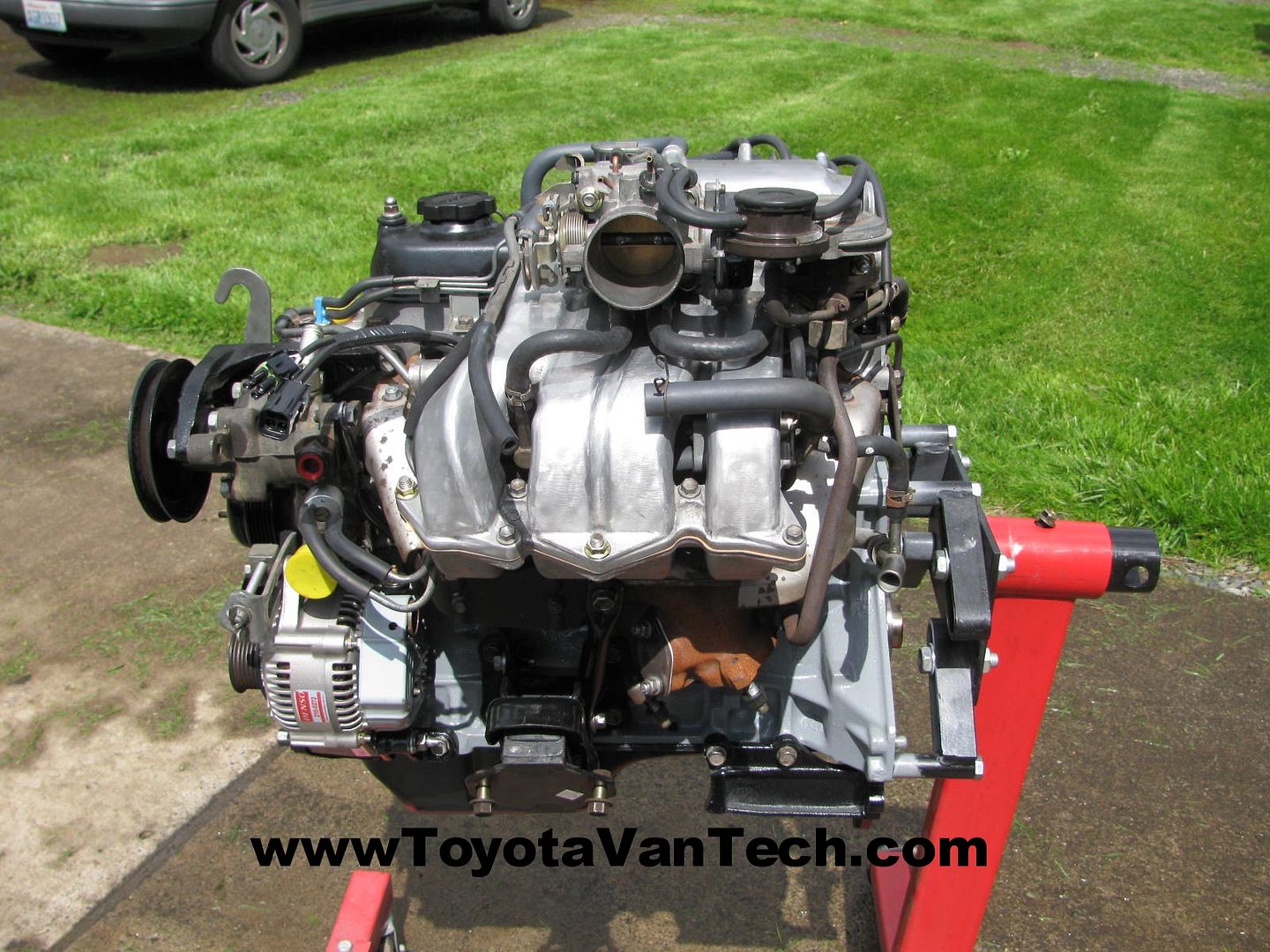
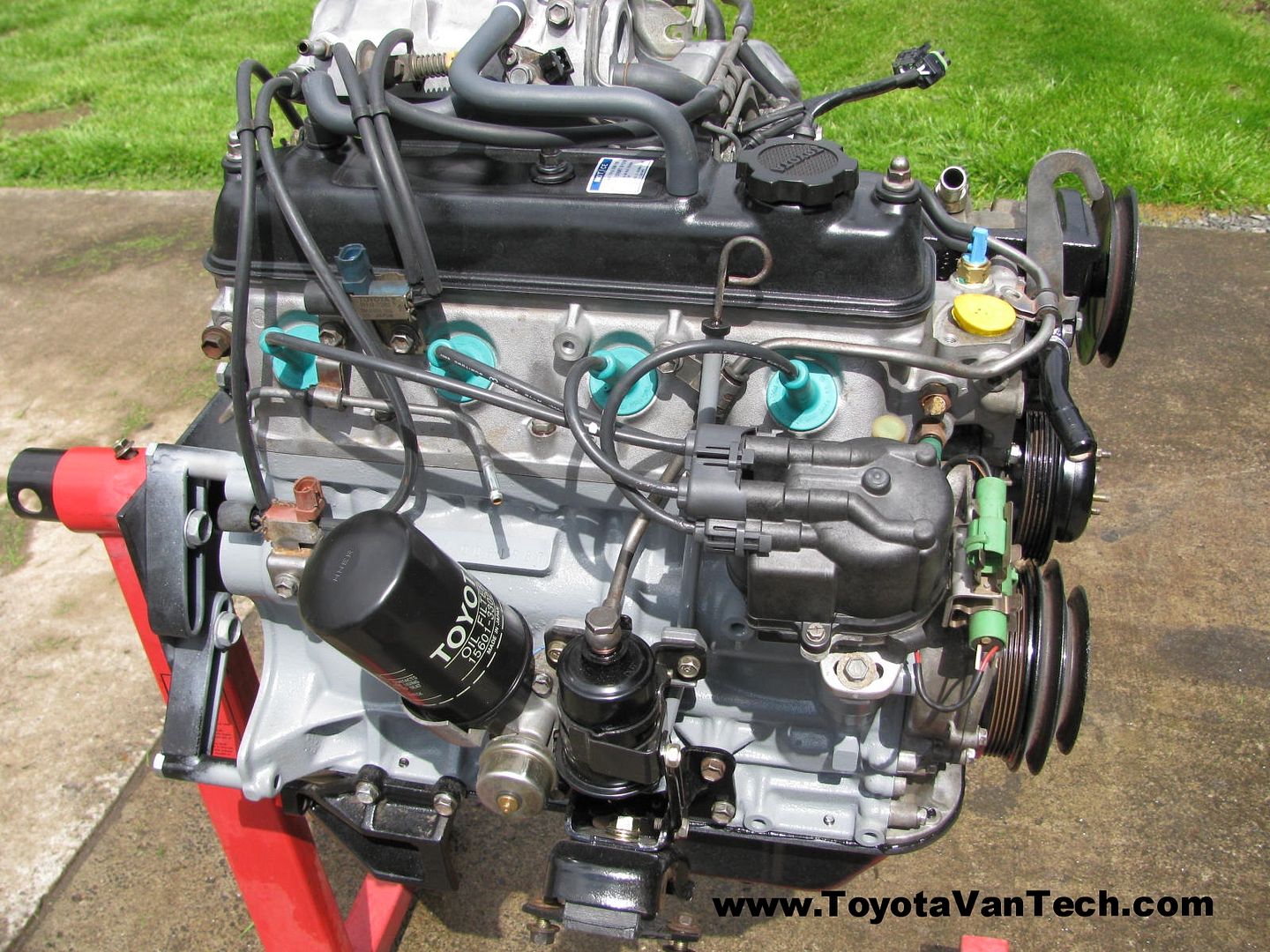
-
Van Enthusiast


- Rep Power
- 1
Re: Blew the rear main oil seal!
Amazing.... Drool. 
Everything upto spec including the oil filter!
Your builds amaze me. Make sure to take a video once the engine is installed and running.
If I ever needed a rebuilt engine again I would without a doubt send you the funds and have you do it if you were willing to.
When my mechanic did mine this is the timeline of how long I had to wait.
Friend Blew HG on July 4th 2010
Mechanic gave me an opening to start working on my van 2 months later around Sept 10th
Mechanic took apart the engine only to find out that the head was bad after it came back from the machine shop Sept 30th
I purchase new cylinder head within a week from clearwater, fl and for whatever reason he finally finishes putting everything back together end of November. (He was working on my van on the weekends, and taking other easy side jobs as priorities.)
Finally when it is all back together engine is running on 3 cylinders and the ignition coil fails after only 10 minutes of driving it for the first time.
Sits all of december, we both were busy. Me for christmas flower deliveries.
Finally does a compression test second week of January to show me that he knows what hes doing, and traces the problem to the #1 fuel injector.
I order a fuel injector and wait the rest of Jan for him to give me an opening, and feb im busy for valentines day so for the first 2 weeks I dont bother. Finally March comes around and Im sick and tired of waiting so I go to another mechanic, have him change the fuel injector out (pay shop price not fun) only to find out its still running on 3, until he fondles with the connectors and bam now its running on 4.
So I waited 8 months almost, but 79,000 miles later engine is running pretty good not burning any oil and no leaks, so I guess I cant complain. But we never did the timing chain or the oil pump. Thats still original so who knows when I will be surpised. I kinda want to see how far it will go.
Now it has been sitting since March as well since my transmission got messed up and I have already put 10,000 miles since then on my new 89 Van. Im just waiting for an opening for him to put the re manufactured transmission I bought from ebay and will report how that works in my transmission thread.
-
Van Fan

- Rep Power
- 1
Re: Blew the rear main oil seal!
-
Re: Blew the rear main oil seal!
So I decide to do some work on the van before dropping the engine into it. I like things clean & since the engine isn't there it's a great time to use the pressure washer on it. 1st I spray some mineral spirits paint thinner in there to loosen up the crud, then I hit it hard with the pressure washer. Here's what it looked like before cleaning.
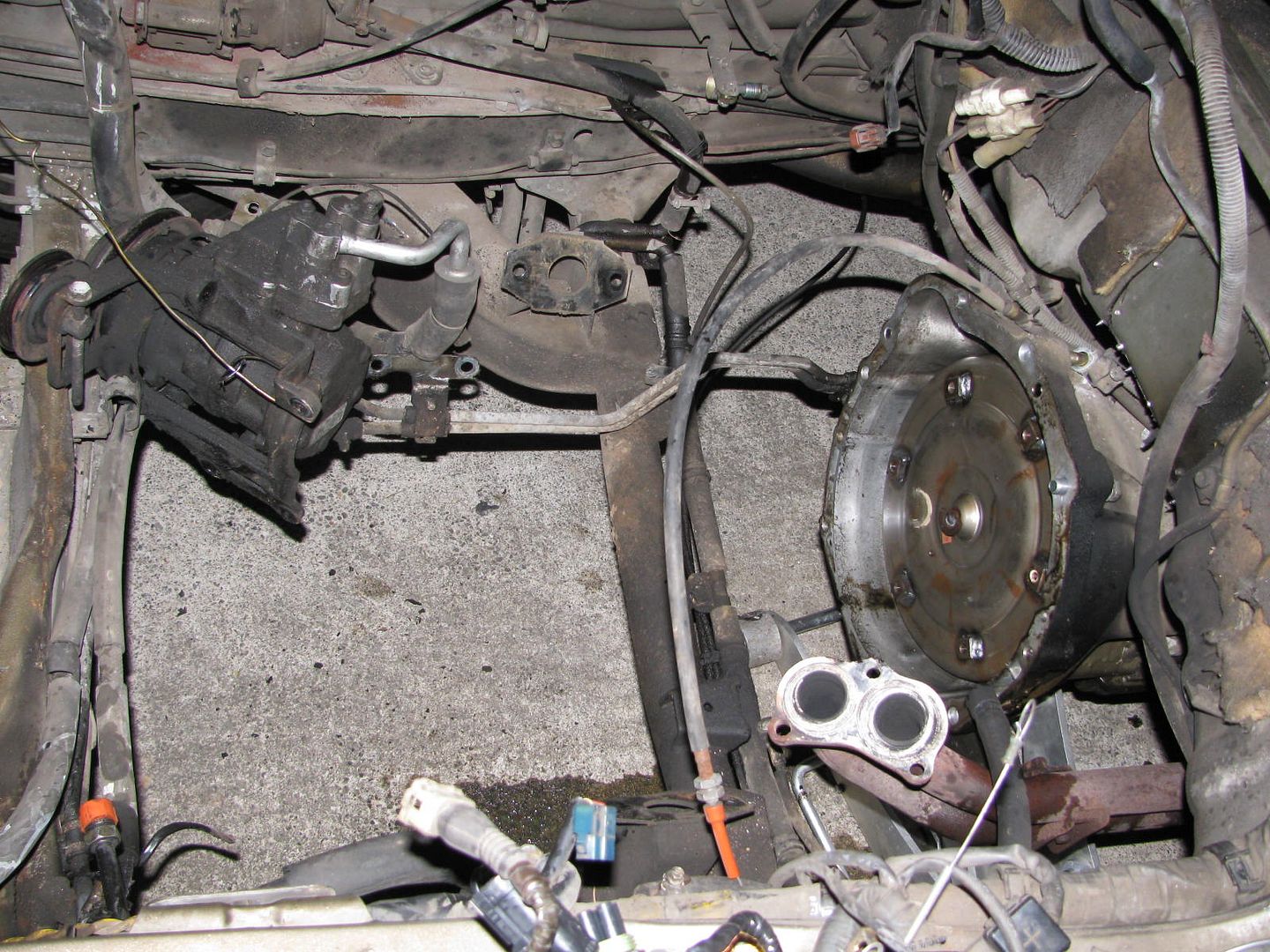
Here's the same area afterwards.
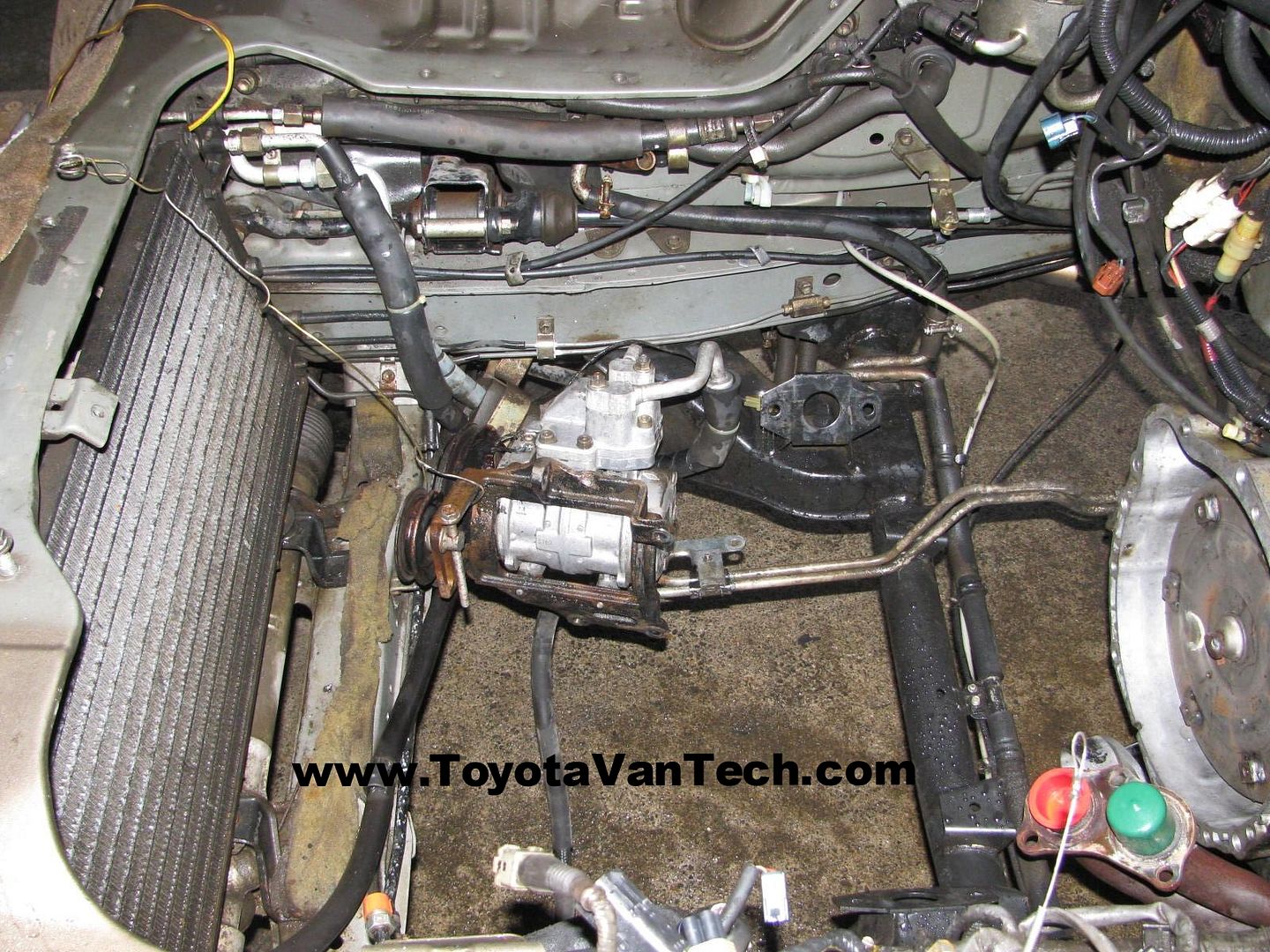
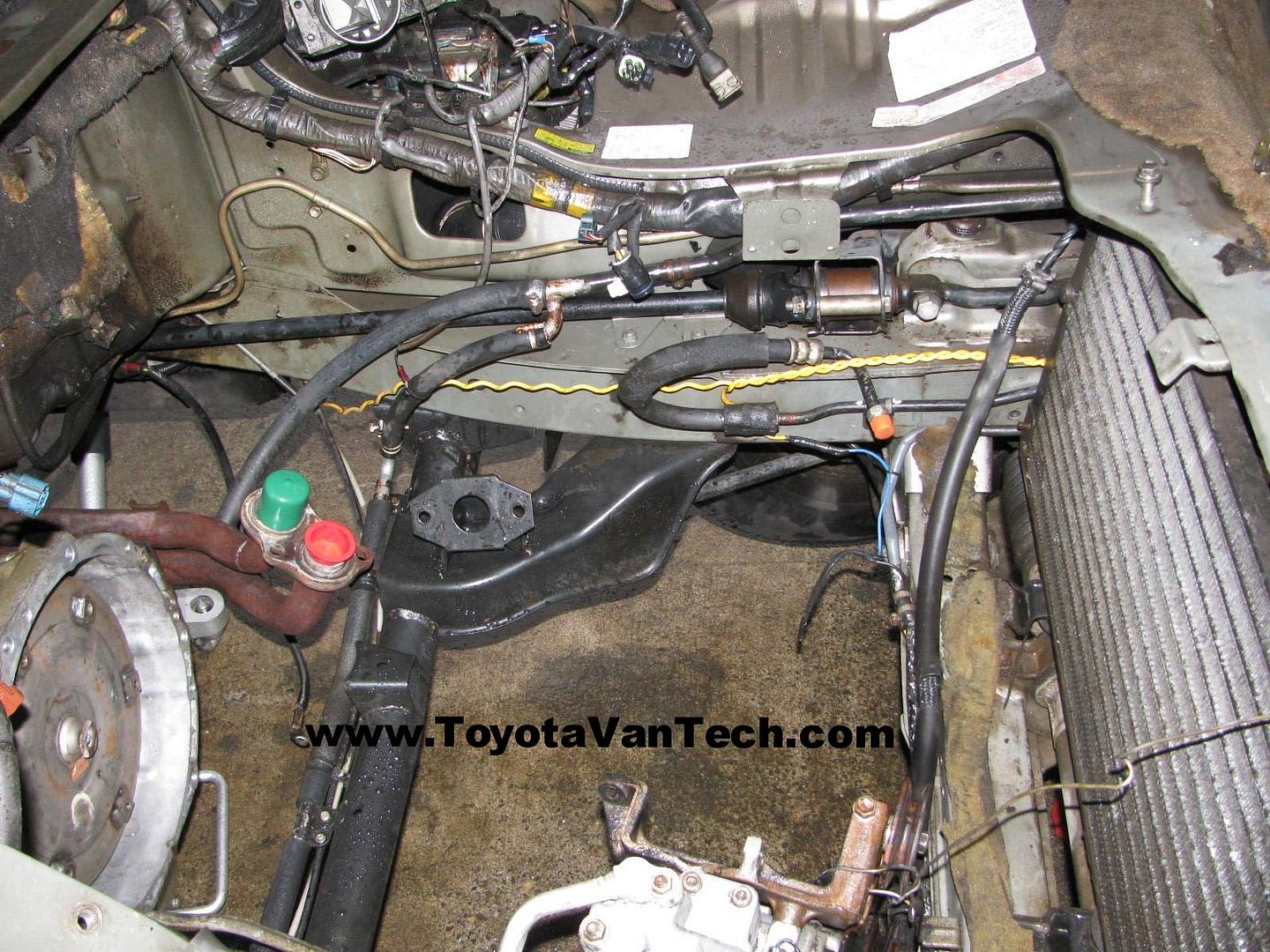
Next I jack it up and change out all the old front heater hoses. I don't use the rear heater (never have). I don't want to invest time or money in something I don't use, nor do I want to risk overheating my new engine due to a 25+ year old heater hose failure, so I decide to eliminate the rear heater system. All I care about is taking it off-line, so I simply cut the metal pipe here & plumb my front engine heater hose outlet directly to the metal pipe (left arrow). I simply ignore the open hose on the back. This will no longer carry coolant.
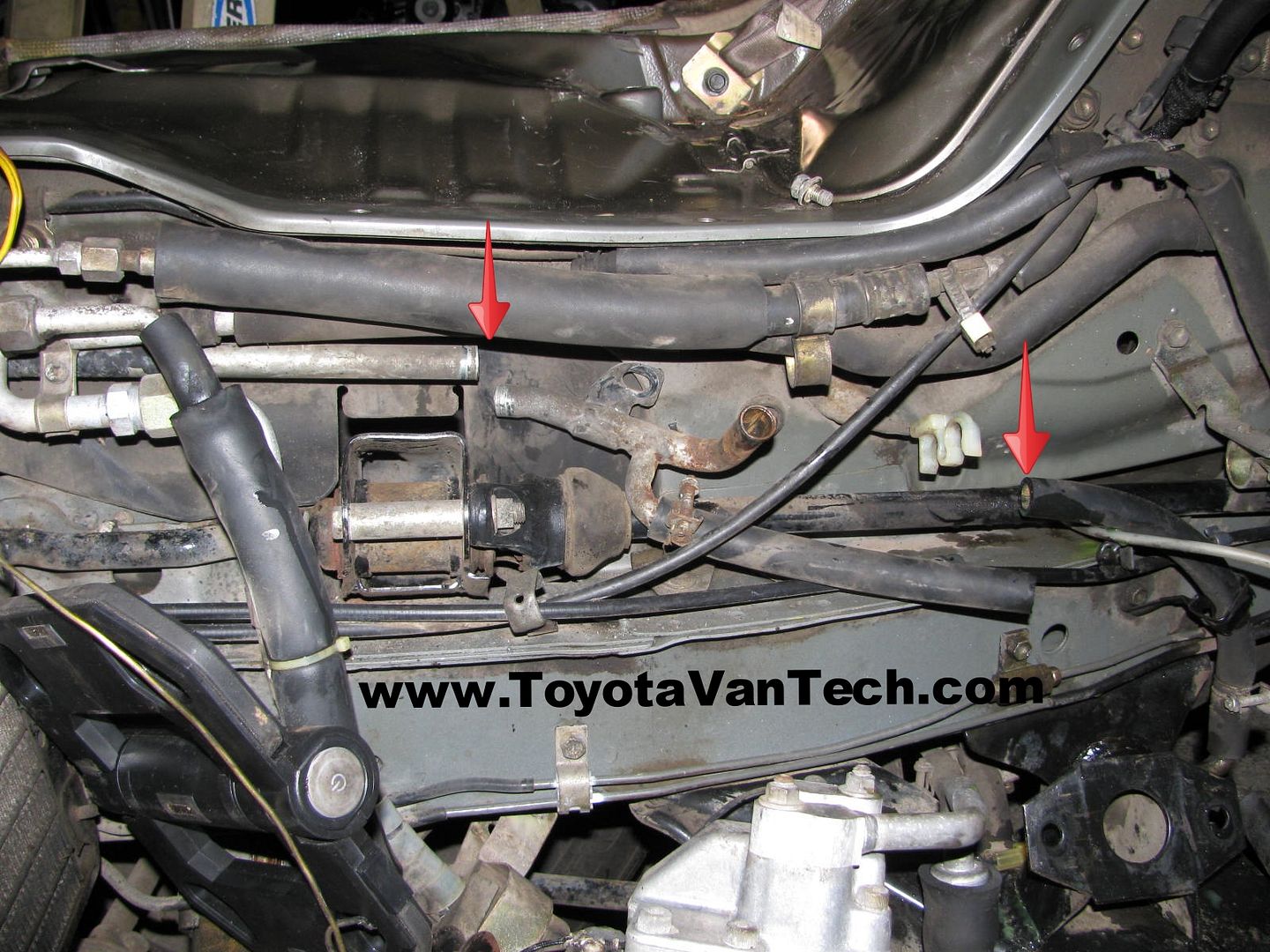
On the driver's side I use my mini pipe cutter here (same thing as I did on the passenger's side)
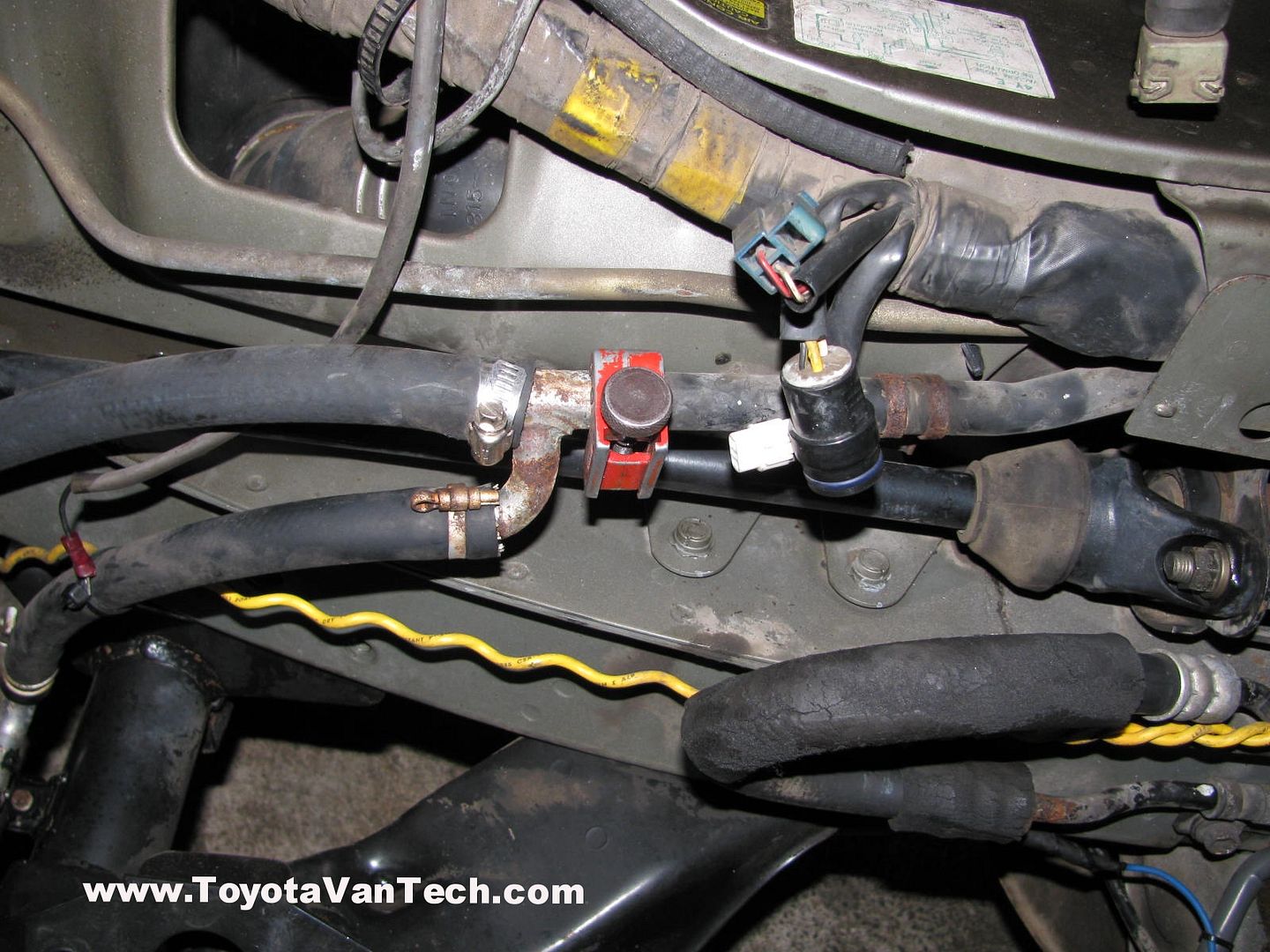
I cut out & remove the stuff aft of this cut point.
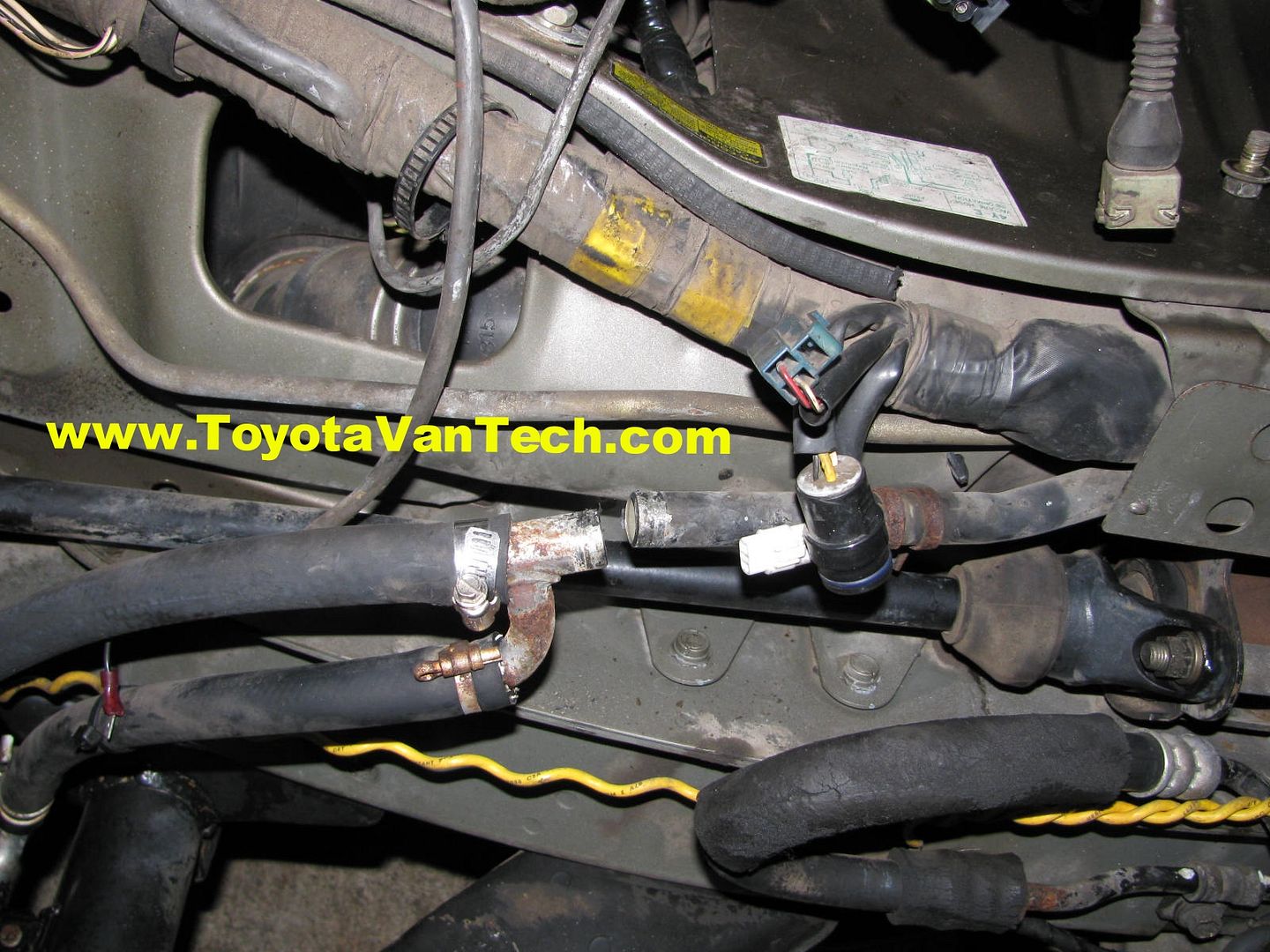
I attach a 5/8" ID heater hose here. Since there is no barb or flare on the tip of the pipe, I slide it on further than normal and use 2 hose clamps. I like the small ones as they put more even pressure on hose (small flat spot). I use 2 clamps & alternate flat spots to minimize the chance of a future leak. Same thing is done on Passenger's side.
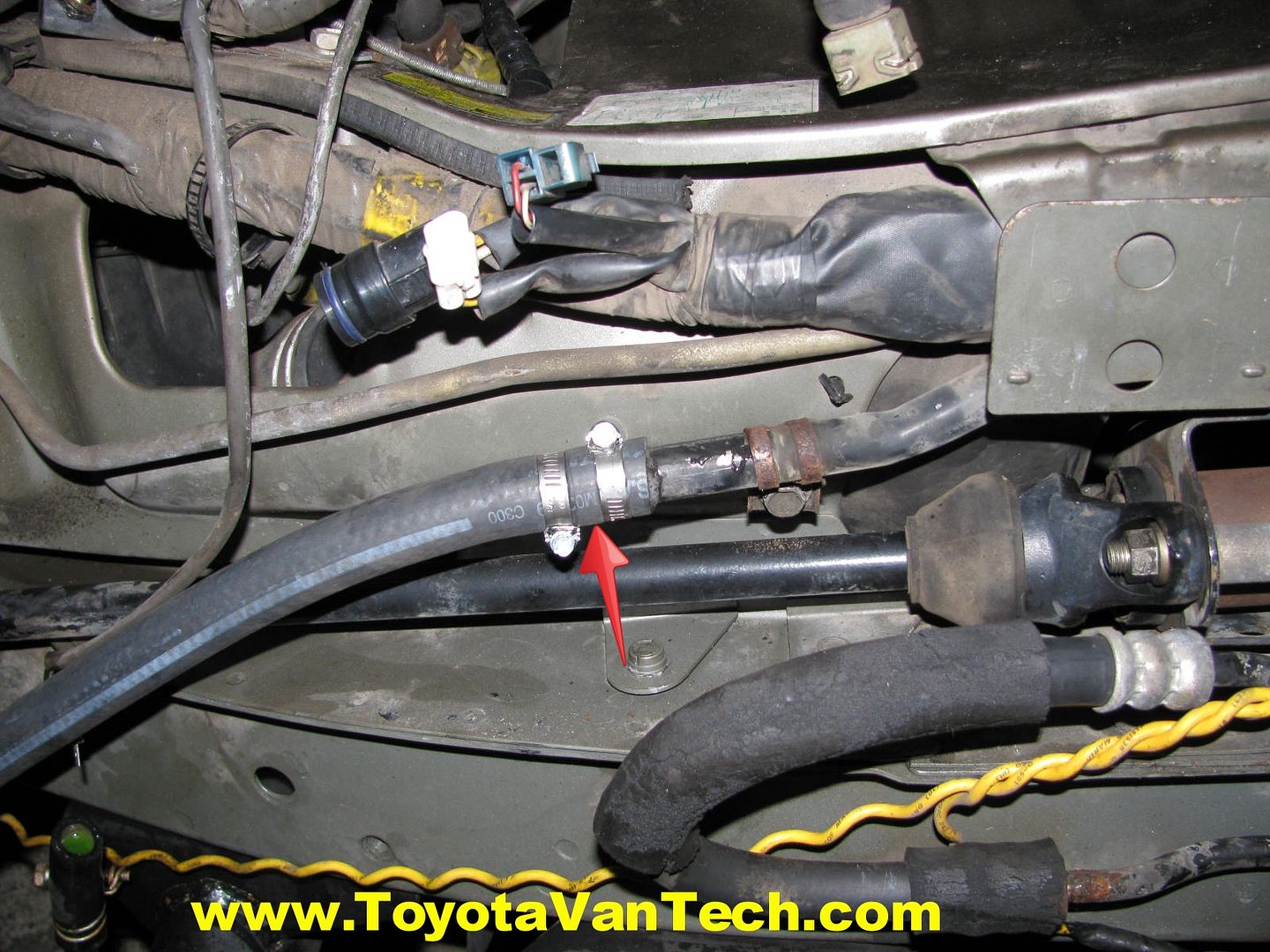
Ready for engine installation! Here's where the other end of the driver's side heater hose goes.
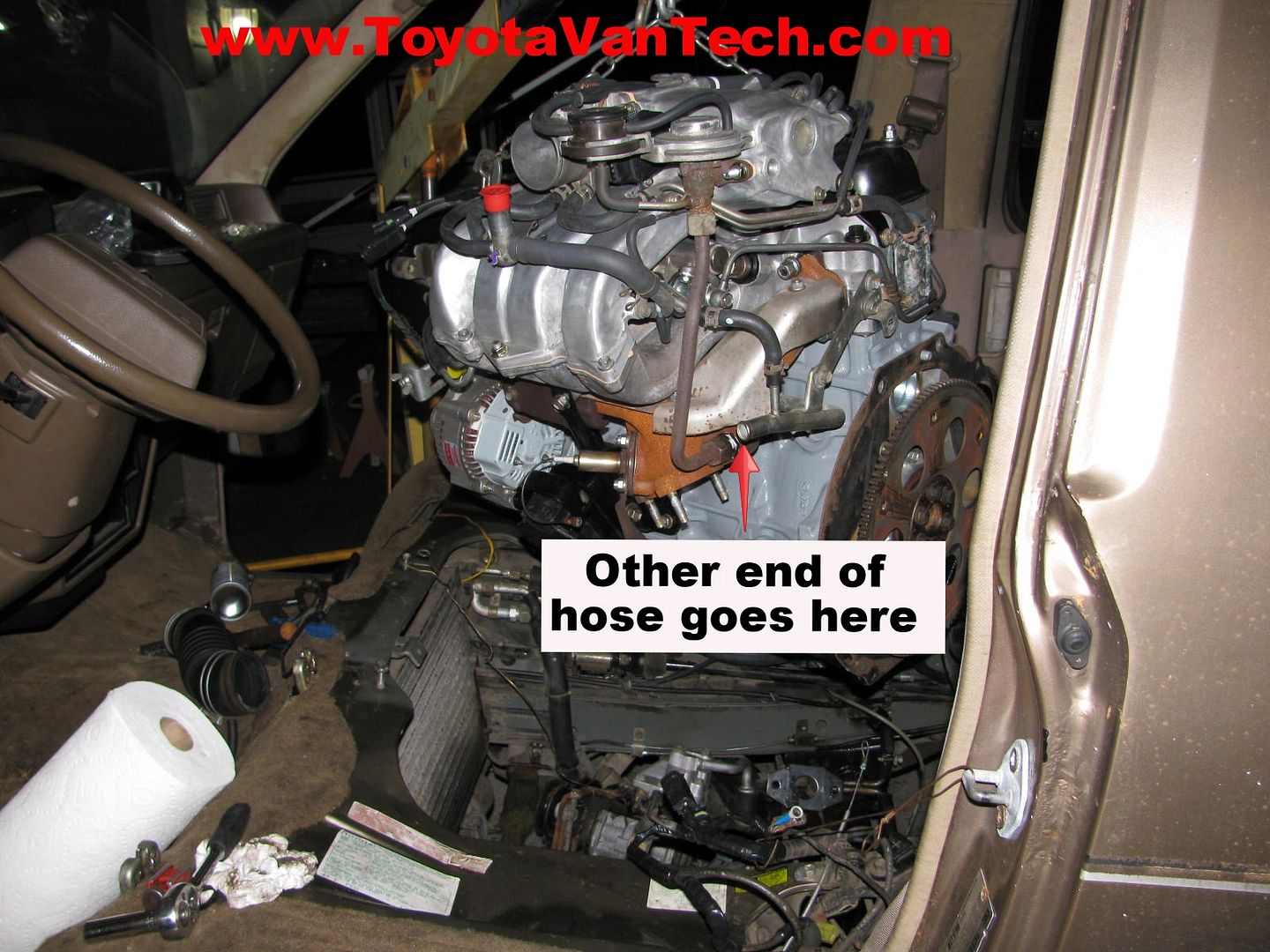
Engine going in.
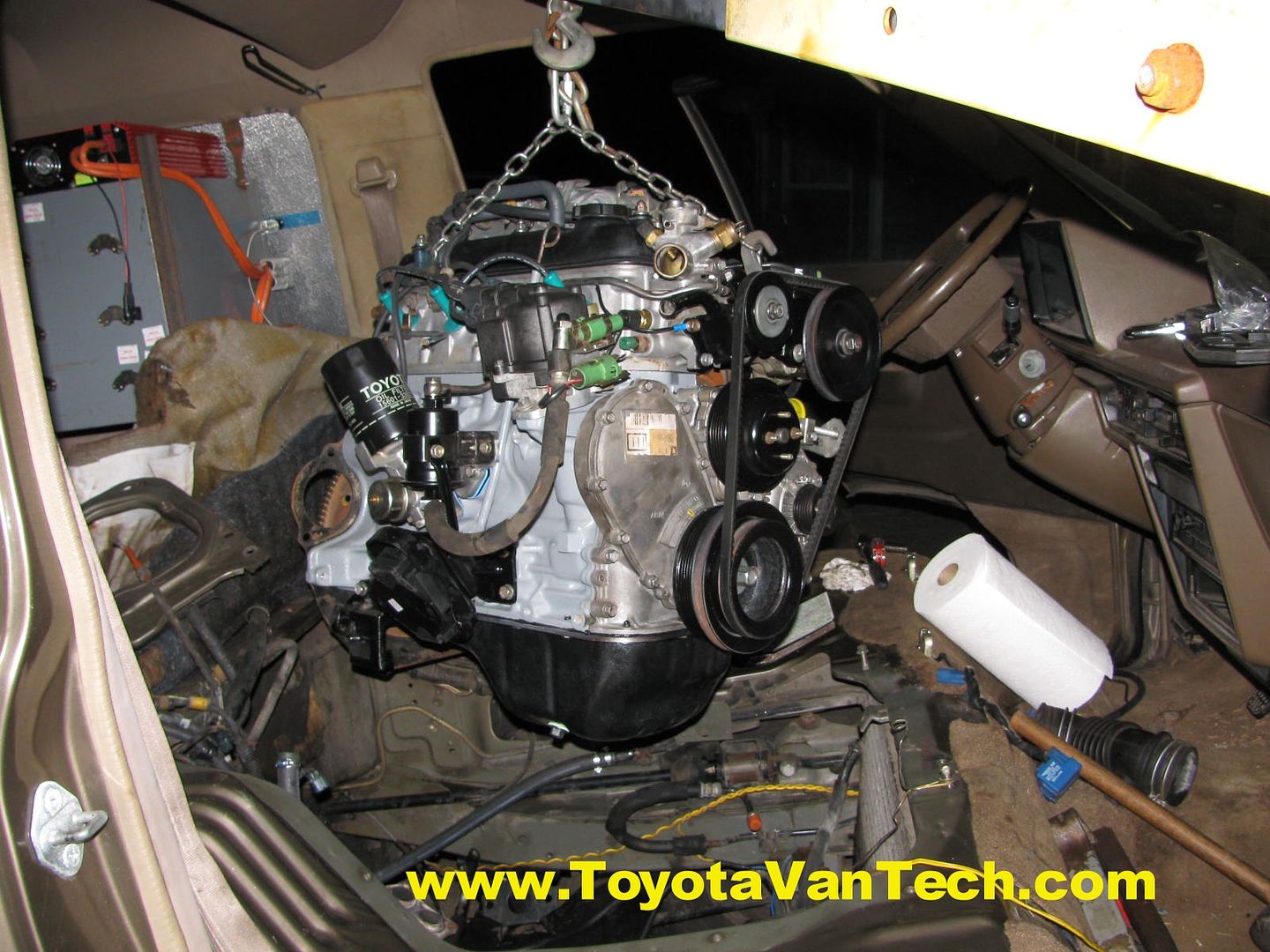
Here's the parts I removed from the system.
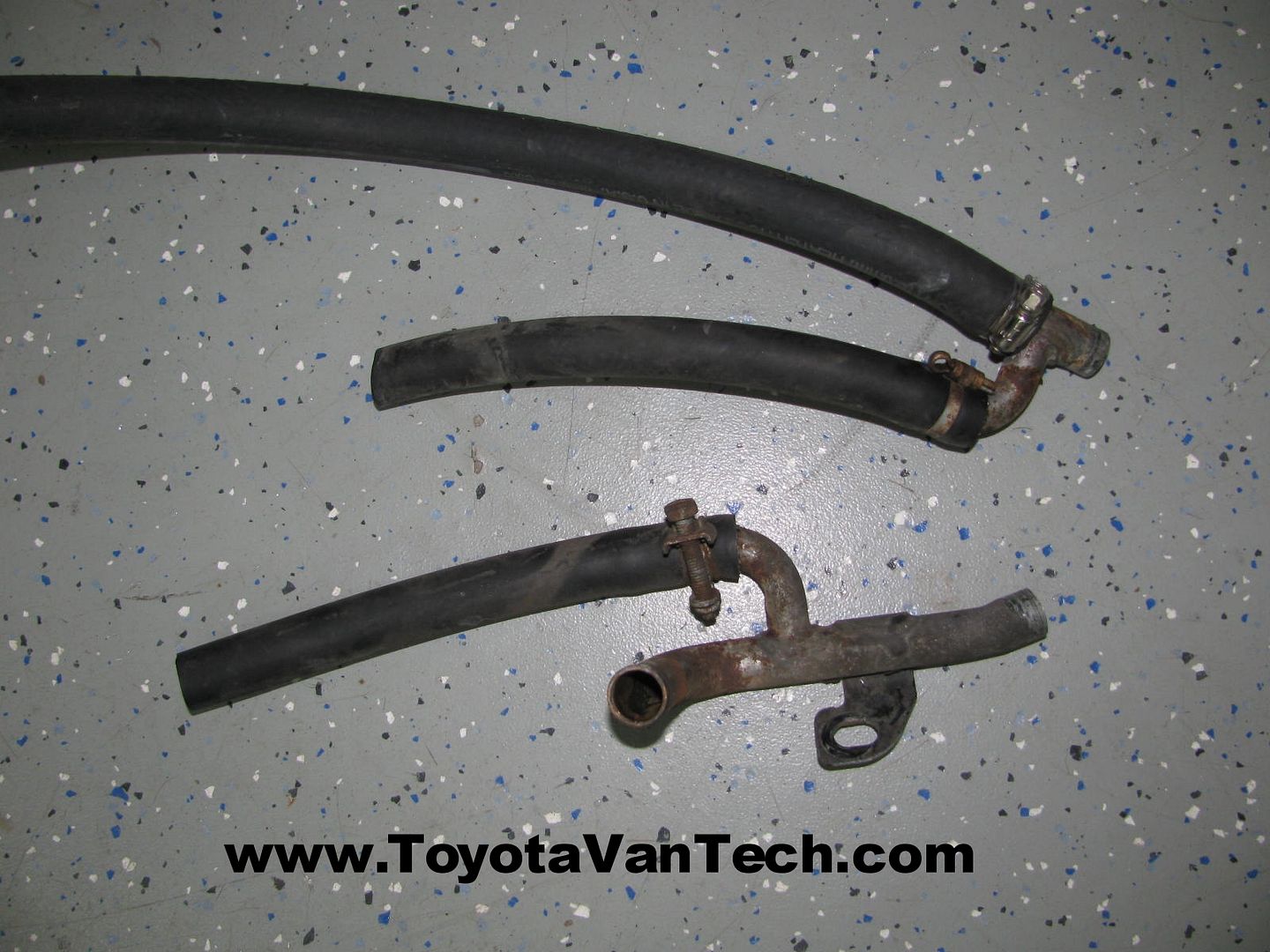
The radiator is origninal, but has never given me any grief. I took it down to Wilson Radiator in Vancouver to get their professional opinion. It was a bit crusty inside so they tanked it and boiled it out. After the tank they pressure tested. Great news! They say it holds pressure & can go back in the van  . After a coat of new paint I pick it up and bring it home. Cost for this service is $125 (worth every penny). Van is put back together with a new clutch fan, all new hoses, new belts, and other misc parts. I install a 220 deg F N/O thermal switch in the extra unused head port and run wire from it to my dash area. I hook up a bright LED light & a loud chime device to alert me in the event of an engine overheat condition (the LED will illuminate & the chime will sound if engine temp exceeds 220 deg F). To see the chime & LED in action CLICK HERE (post #17). I also rig up my electric radiator fan on a timer to run 15 minutes after each hot shut-down (this is to eliminate hot soak issues). To see schematic of this timing device & For more on this subject CLICK HERE & see post #34, 38, & 39.
. After a coat of new paint I pick it up and bring it home. Cost for this service is $125 (worth every penny). Van is put back together with a new clutch fan, all new hoses, new belts, and other misc parts. I install a 220 deg F N/O thermal switch in the extra unused head port and run wire from it to my dash area. I hook up a bright LED light & a loud chime device to alert me in the event of an engine overheat condition (the LED will illuminate & the chime will sound if engine temp exceeds 220 deg F). To see the chime & LED in action CLICK HERE (post #17). I also rig up my electric radiator fan on a timer to run 15 minutes after each hot shut-down (this is to eliminate hot soak issues). To see schematic of this timing device & For more on this subject CLICK HERE & see post #34, 38, & 39.
Here's the engine after installation.
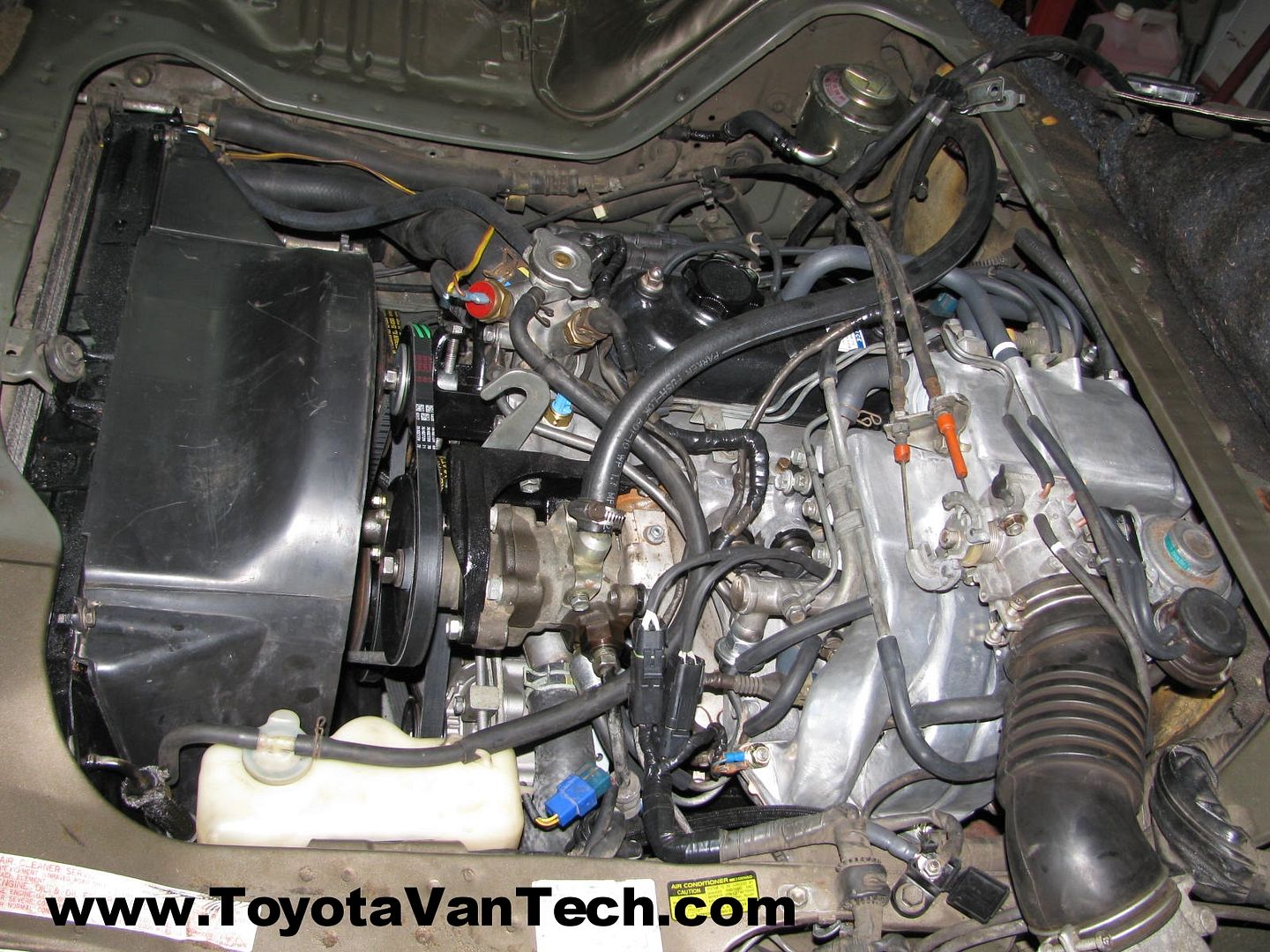
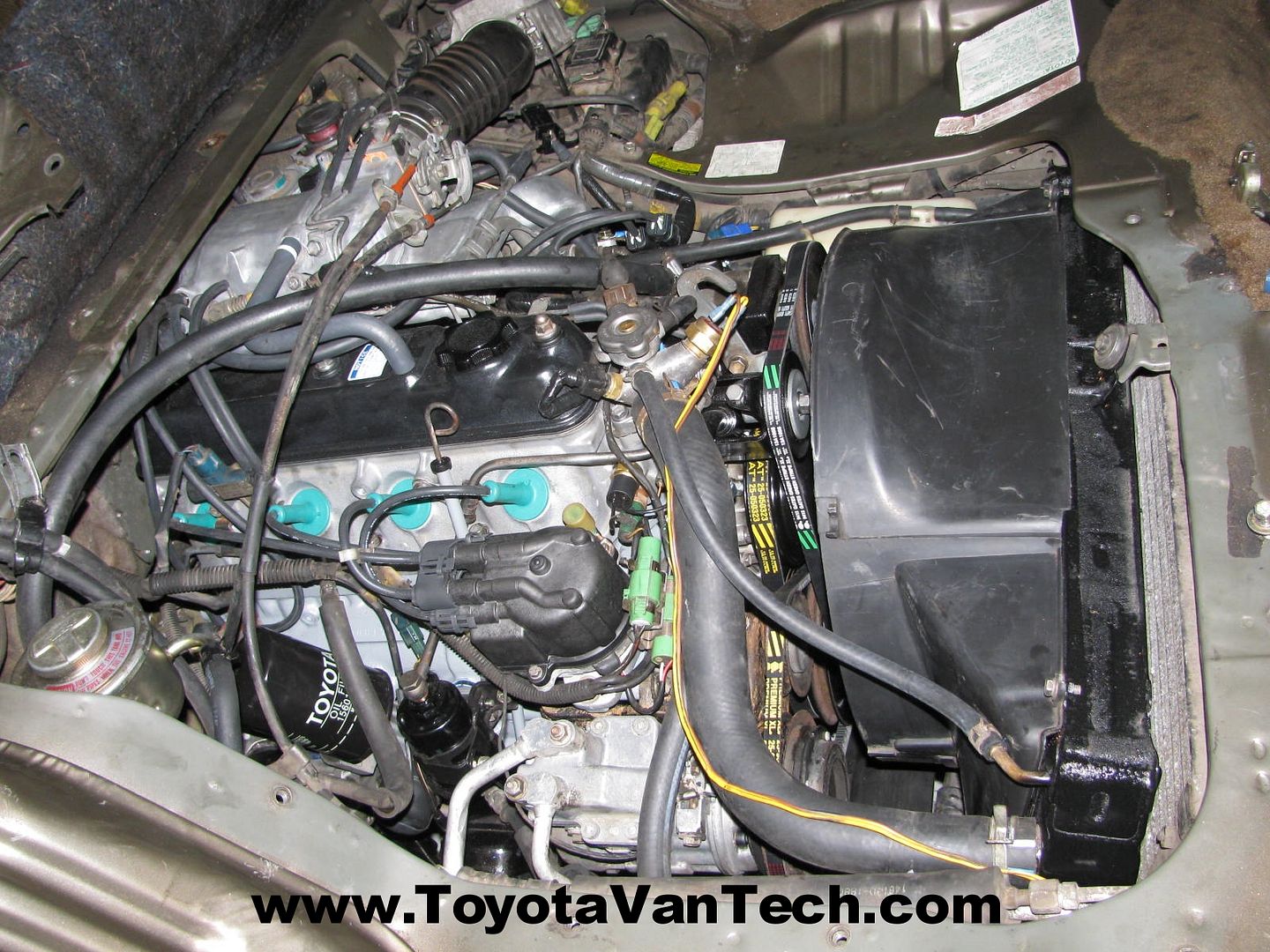
I got it started and it runs awesome! There's no leaks, no smoke, and no knocks. 
-
Forum Newbie

- Rep Power
- 1
Re: Blew the rear main oil seal!
that looks amazing! i love how you clean everything. i wish i could get my engine that clean without taking it out. it would take forever though.
thanks for the great pics and info
-
Van Fan

- Rep Power
- 1
Re: Blew the rear main oil seal!
Great job Tim... It looks awesome.
-
Re: Blew the rear main oil seal!
Update: Made it 4,500 miles since the overhaul & just added oil for the 1st time today. It wasn't to the "add" line yet, but it was low enough to accept about 3/4 of a quart. The oil still looks clean. I rotate my tires and change oil in 5,000 mile intervals. It could have made it there without adding oil, but I like to see it topped off. No noticeable amount of coolant was used since the overhaul so that's good too.
Van has run excellent & I'm very happy with it. It gets run hard (mostly freeway miles) and I tow a trailer about 1/4 of the time. It's been a hot summer & the AC runs almost non-stop. Even with all this heat and hard work the van stays cool. As I mentioned earlier I rigged up an alarm system (chime and LED light) to alert me if engine temps exceed 220 F. I found this to only occur when I run AC for extended periods while van is at idle (stuck in traffic or while sitting in a parking lot). To remedy this I rigged up my AC compressor to a relay that prevents compressor operation whenever engine temp exceeds 220 F. This way I don't need to worry about it if the van is left running with AC on with me not in it, and the interior still stays reasonably cool. Tim
-
Van Addict

- Rep Power
- 1
Re: Blew the rear main oil seal!
Great thread Tim! Thanks for all the part numbers and explanations. I bought the FPD new from rockauto for my rebuild but it wouldn't go in easy so I used the old one(Toyota). Now I see you have chased it with M12x1.25 so I'll do that.
And the wiring harness is brilliant because it is such a pain to install the intake manifold and hoses when the engine is in the van due to no access at all-even with 2 access holes!
-
Re: Blew the rear main oil seal!
Thanks for the kudos! Another side benefit to having a harness set-up like this is being able to check injectors without disassembling. I can check resistance and test fire each injector by disconnecting the harness & getting access to them electrically. This can be helpful when troubleshooting and can possibly save you the labor of pulling the upper intake. Tim
-
Van Fan

- Rep Power
- 1
Re: Blew the rear main oil seal! [Engine Overhaul]
220 degrees isn't too bad, actually, for running it hard. I had my Cobalt running at 246 degrees climbing hills at 80 MPH on our way out of Phoenix to Las Vegas. You can never be too safe though.
-
Re: Blew the rear main oil seal! [Engine Overhaul]
I guess I posted too soon that everything was great because it started running bad yesterday. After troubleshooting I determined the trouble was with #3 injector........AGAIN!!!. Damn-it this is the 4th time for this van plugging up #3 injector screen.............and these are fresh rebuilt injectors (although not the injectors fault). So today I ripped the top intake off and cleaned injector screens..........AGAIN! Man I'm getting sick of this. It's due to the contamination of the fuel system (talked about earlier in this thread). I figured cleaning the tank and and regular filter replacements would be adequate, but evidently not. So I just got back from my test drive and it's all good again, but I need to do something about this.
I'm speculating that it's crud on the inside walls of the fuel lines dissolving, breaking loose, and somehow making through the fuel filter to the injectors. Evidently the micron size of the injector screens is smaller than the micron size of the fuel filter.......REALLY? (I can't find any specs on the filter or the injector screens). There really aren't any noticeable debris inside the injector screens, but during close inspection with a magnifying glass I can see the mesh mostly plugged on #3. The others were starting to plug but not nearly as bad. I guess my choices are 1. keep doing this every 5k miles (not gunna happen) 2.replace all the fuel lines, 3. install an aftermarket filter or 4. poke hoes in my injector screens  . I'm sort of kidding on that last one, but I'm wondering if these particles are big enough to foul up the injector nozzles (if allowed to travel through). Same difference really because fouling the nozzles isn't any extra labor to clean. Even if I only get an extra 5k miles it would be worth it.
. I'm sort of kidding on that last one, but I'm wondering if these particles are big enough to foul up the injector nozzles (if allowed to travel through). Same difference really because fouling the nozzles isn't any extra labor to clean. Even if I only get an extra 5k miles it would be worth it.
So I'm going to research this and decide what to do............and it's not going to be option #1. I'd just assume pull the engine back out and junk the thing if I'm going to need to pull the injectors every 5k miles (like I have been). Looks like cleaning the tank wasn't good enough. Tim
-
Van Addict

- Rep Power
- 1
Re: Blew the rear main oil seal! [Engine Overhaul]
Might need a screen right before the fuel rail. I don't know how though.
I had the same problem with the #1 injector with my rebuild. I put in a used hard line from the filter to the Damper and it clogged right away-I cleaned it first but not enough I guess. It took me forever to figure it out.
I practiced cleaning out the injectors on a junk yard set so I wouldn't mess up my newly reconditioned ones from Dr. Injector. Getting to my point-When I looked at the screens from the junk yard injectors they had more area(screen size) than the ones from Dr. Injector. I love the work he did to clean and rehab my old injectors but I hesitate to say, his screens looked smaller to the naked eye-It may well have clogged anyway I don't know. Maybe it's worth it to check out the OEM injector screens?
-
Re: Blew the rear main oil seal! [Engine Overhaul]
I ended up ordering a 10 micron fuel filter with replaceable paper elements and I also ordered new screens for my injectors. I had noticed the exact thing you did when comparing to my old injectors & believe the screens DR injector used are of a finer mesh & less surface area (bad combination for my particular situation). Anyhow, here's the filter & the screens I ordered:
http://www.jegs.com/i/Aeromotive/027/12308/10002/-1
http://www.jegs.com/i/Aeromotive/027...oductId=754043
http://www.hyperracing.com/pages/hom...oduct=602-6049
I'm going to eliminate the factory fuel filter and use only this one. I got some extra paper elements & these will be easier to replace & cost less than the factory ones. I'll post updates when I install these. Tim
-
Van Fan

- Rep Power
- 1
Re: Blew the rear main oil seal! [Engine Overhaul]
Not a bad idea. Gordan Ramsay would blush if he ever witnessed me trying to replace the stock fuel filter. Those injectors wouldn't be clogging up if it wasn't for that damn ethanol. I remember getting 26-29 MPG before that roflroflroflrofl was added in.
-
Van Addict

- Rep Power
- 1
Re: Blew the rear main oil seal! [Engine Overhaul]
Looking forward to seeing this mod.
Tags for this Thread
 Posting Permissions
Posting Permissions
- You may not post new threads
- You may not post replies
- You may not post attachments
- You may not edit your posts
-
Forum Rules
If this one's good, I'm going to assume they're all good
.

. So here's the thing, I really don't want to spend a lot of money on this (futile, I know) and I don't want to delay this project, so I grind down the high spots on both bolts & install them back in the same spots as before
. It's not the high road, but it does the job. Once back together I check for end play and it falls into an acceptable range. I rotate a full revolution and verify there is no more rubbing/grinding on the bolts. When I have time I'm taking the other 2 gears to my local machinist and having this material removed. Next engine I do WILL NOT have this issue!


.




. After a coat of new paint I pick it up and bring it home. Cost for this service is $125 (worth every penny). Van is put back together with a new clutch fan, all new hoses, new belts, and other misc parts. I install a 220 deg F N/O thermal switch in the extra unused head port and run wire from it to my dash area. I hook up a bright LED light & a loud chime device to alert me in the event of an engine overheat condition (the LED will illuminate & the chime will sound if engine temp exceeds 220 deg F). To see the chime & LED in action CLICK HERE (post #17). I also rig up my electric radiator fan on a timer to run 15 minutes after each hot shut-down (this is to eliminate hot soak issues). To see schematic of this timing device & For more on this subject CLICK HERE & see post #34, 38, & 39.





. I'm sort of kidding on that last one, but I'm wondering if these particles are big enough to foul up the injector nozzles (if allowed to travel through). Same difference really because fouling the nozzles isn't any extra labor to clean. Even if I only get an extra 5k miles it would be worth it.



